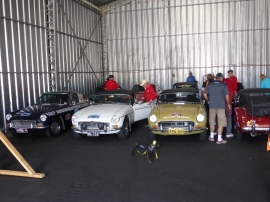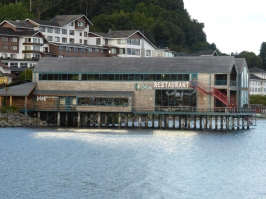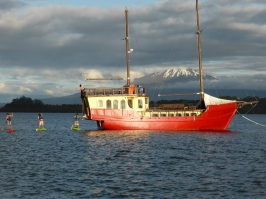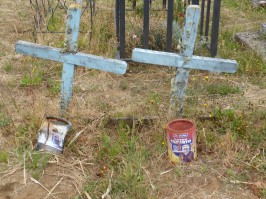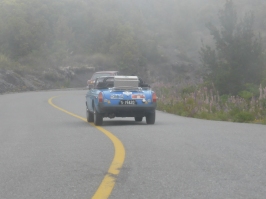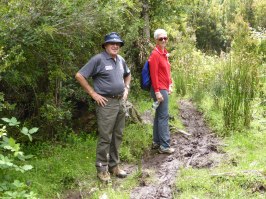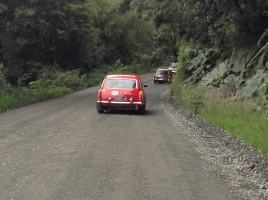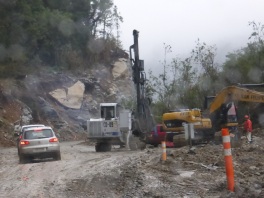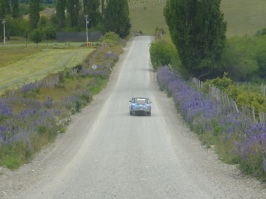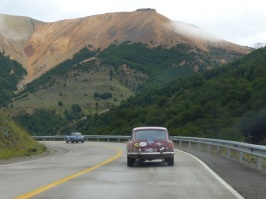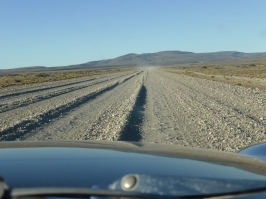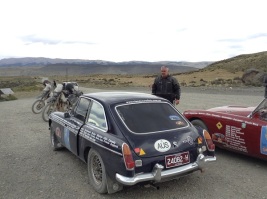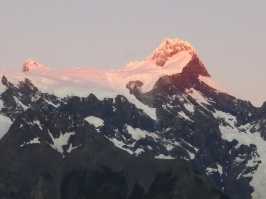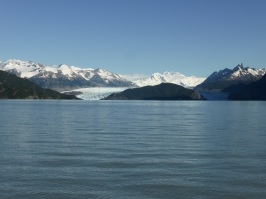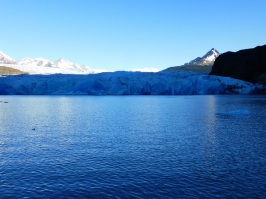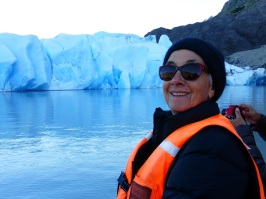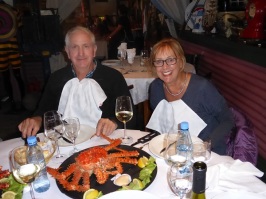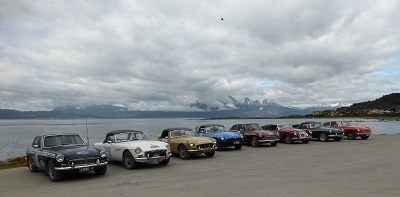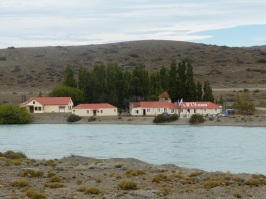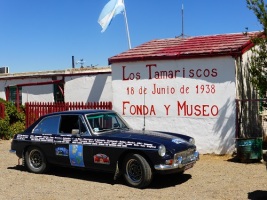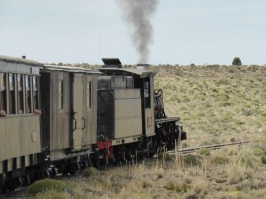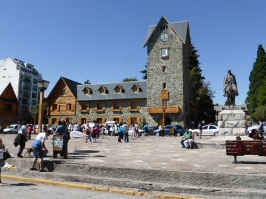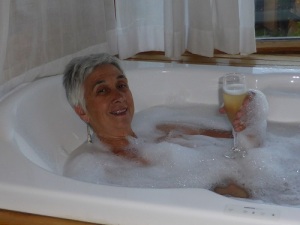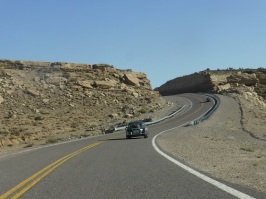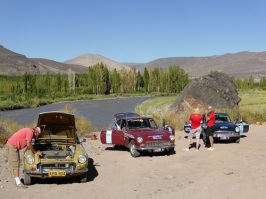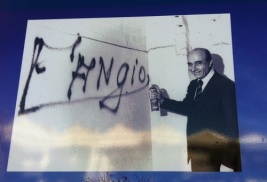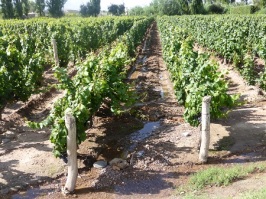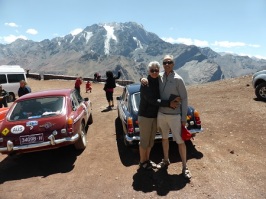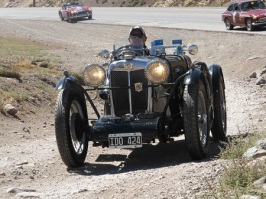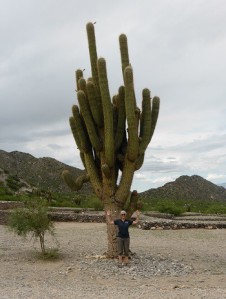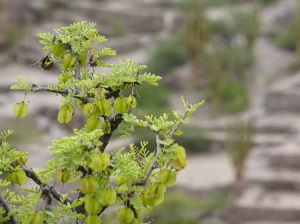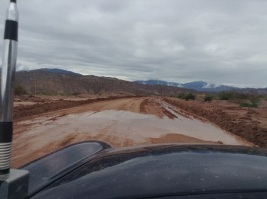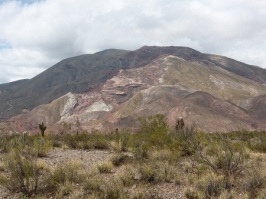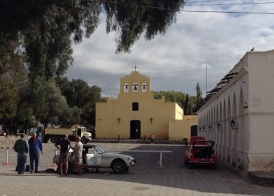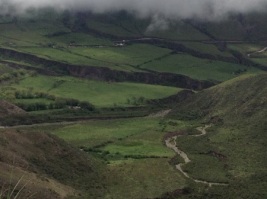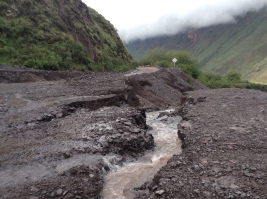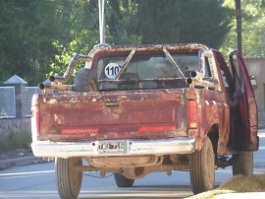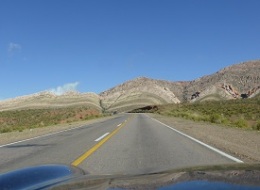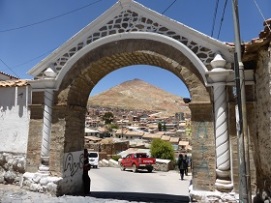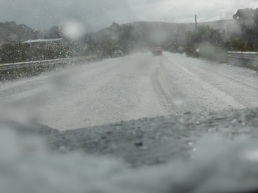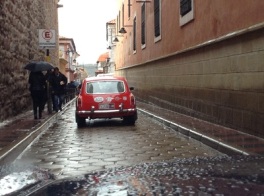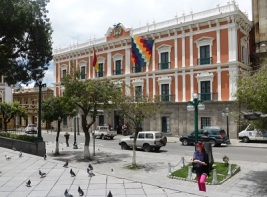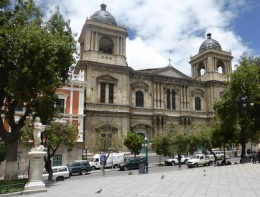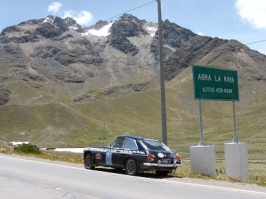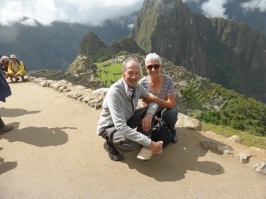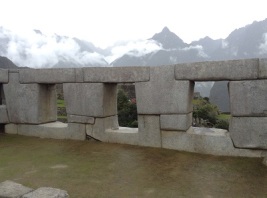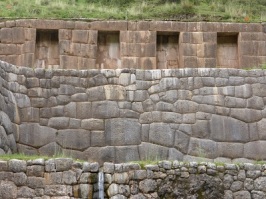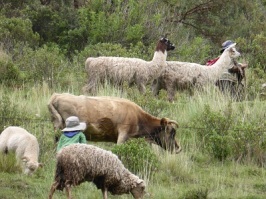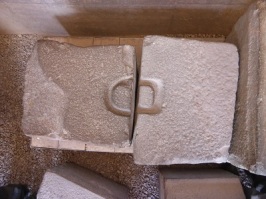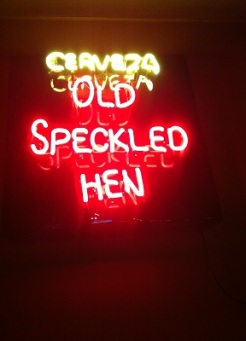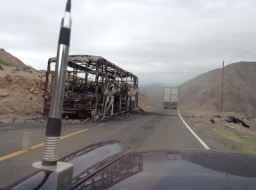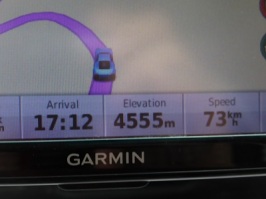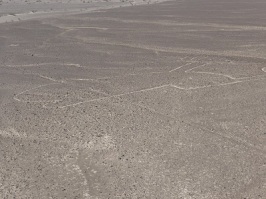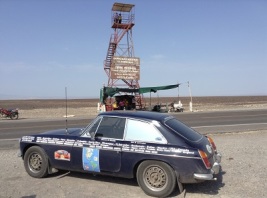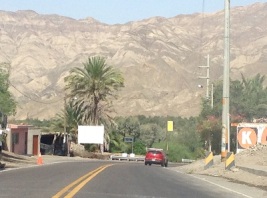Arrived in Santiago
Posted on Jan 6, 2015
Everyone has now arrived in Santiago where we were told it doesn’t rain from October to March. A beautiful city by South American standards where a battalion of park workers armed with hoses connected to an abundant stream direct from the Andes make sure everything stays green. On our first evening, John found a nearby restaurant which promised to deliver the authentic Chile experience, and it did in spades. One end of the table groaned under the weight of two huge plates of steaks and blood sausages while at the other end where the majority were sitting, a few pieces of undercooked fish were shared sparingly. There may be a parable somewhere in this.
Today we all shook off the jet lag and headed into the old part of town using the very efficient Metro. We had split into several groups but ended up bumping into each other at the Pre Columbian Art Museum where we all pretended to know more than we really did about the history of the various civilisations of South and Central America. Dave came up with the most challenging version in which the original settlers of South America and Australia all originated from Antarctica….hmmm,
We also walked through the city square where Allende was overthrown by his military on 11 Sep 1973 but couldn’t find any apparent evidence of the bullet holes.
Santiago’s most popular tourist spot is the 900m high Cerro San Cristobal with its impressive statue of the Virgin Mary unfortunately now dwarfed by a huge communication tower located less than 50 metres away. You would have thought in a country where 90% of the people are Catholics that they could have come up with a better idea. We started on the walk up the hill to avoid the lengthy queue for the funicular railway but after two false attempts at finding the right track, gave up and walked back to the now much shorter queue. A much better option on a 32 deg day and both the views and cool breeze at the top were appreciated.
An early start is planned to tomorrow when we get a bus to pick up the cars…
Picked up the cars
Posted on Jan 9, 2015
Our first attempt to pick up the cars from the San Antonio port turned into the usual paperwork drama with disagreement between Australian and Chilean customs agents about what documents were required. Things were looking bleak when the Chilean customs boss said he would only accept an original document mailed from Australia before the cars could be released but Ignacio, our Chilean agent came to the rescue and produced an acceptable alternative after a 3 hour round trip back to his office in Santiago. By this time it was too late to process the cars so we came back first thing Thursday and by lunchtime were allowed into the warehouse to check the cars. Most cars started without problems although one of the cars was missing a UHF radio. Ours had been unscrewed and was lying on the floor with all the cables still connected so we can only assume someone had been disturbed in the act. A short wait for siesta to finish and gates re-opened and we were off for the drive to our hotel in Valparaiso.
The hotel is in Vina del Mar, just along the beach from the centre of Valparaiso. Originally a vineyard, it became the place to live after the 1906 earthquake which just about destroyed Valparaiso. We learnt that Valparaiso, sometimes known as ‘little San Francisco’, shares many features with its US sister city apart from both being flattened by the same earthquake. Both have many beautiful timber buildings and in recent times Valparaiso has been designated a UNESCO world heritage site and become a magnet for the arts.
Today is a rest day so the hotel garage has become an MG workshop as everyone puts in their final preparation for the driving trip which starts tomorrow. The cars created plenty of interest when we arrived yesterday so this might be setting a pattern for the next weeks.
Valaparaiso to Temuco
Posted on Jan 12, 2015
Everyone was ready to hit the road at 8 am despite a few bleary faces – some of our rooms were directly above the dance floor where the action started late and went through until after 3 am at a million decibels. We are learning they like their music VERY LOUD!
No dramas getting out of Valparaiso and we have decided to take the scenic route close to the coast. Morning tea spots were hard to find so we ended driving through a camp ground to a riverside area where a large crowd quickly gathered and the kids figured out we had a good supply of clip on koalas. All good until Guy, Laurel’s son who has joined the trip for a few days with his Chilean girlfriend Andrea, manages to lock the keys of his rental JAC in the ignition. Good move to prevent possible theft by the young kids but it almost defeated us too. Fortunately the local break-in expert arrived and with the help of a large screwdriver, a piece of wire and a loop of dental floss, the lock was lassoed and pulled up. Phew! Have to say the JAC is such a rubbish car some might have been tempted to leave it there. Chinese cars, buses and trucks from dozens of brands are everywhere on Chilean roads. The Higer bus we took to pick up the cars from San Antonio was comfortable enough but it couldn’t get up hills to save itself and had axle whine which would have appalled Roger -“A singing axle is a happy axle”- Gibbs.
For the final leg we took Ruta 5, the Pan American Highway which today is a fairly boring 4 lane tollway. Good value at around $5 per 100 km and certainly a good way to cover large distances quickly. We have been surprised at the high standard of Chile’s roads – even the secondary roads in this part of the country are better than the equivalent roads in Australia.
Our overnight stop on 10 January is the Tabonko Guest House at the Gillmore Winery where we meet our warm and generous hosts Andreas and Daniella. They are the owners of the winery which has a history going back around 400 years to the time when the Spanish first settled around Concepcion, now Chile’s second largest city. Like many small boutique wineries they are concerned about Chile’s reputation as an exporter of low cost quaffing wines and are concentrating on just two varieties, Cabernet Franc and Carignan. Granitic soil, dry irrigation and good winemaking techniques make some great food wines which we enjoyed with slow cooked beef and turkey. We were interested to learn why Chile now mostly grows French grape varieties. Andreas explained that some Chileans became very wealthy in the 19th century, mainly through exports of phosphates, and developed a taste for everything French, including their architecture and wines.
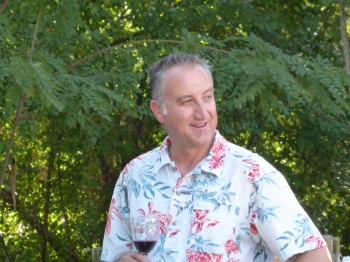

Another beautiful sunny morning and we again have a choice between a boring 5 hours along the tollway or the 8 hour scenic route. Not a hard choice, we took Daniella’s recommendation to drive towards Concepcion via the costal route. Lots small fishing villages, with families camping on the beaches enjoying the black sand and modest surf. Apart from a short section of gravel road, Ruta del Mar must be one of the best coast roads anywhere in the world, right up there with California’s Highway 101 and the Great Ocean Road but with almost no traffic. The only disappointment is a 70 km/h limit in the interesting bits. Then back to Ruta 5 for the final 250km to our overnight stop in Temuco.



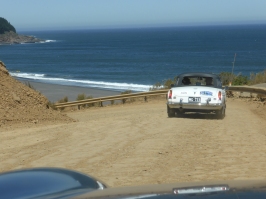
Our hotel was another huge casino, similar to the one in Vina del Mar so we opted to eat out. Not much open on a Sunday evening so we all ended up at a nearby Italian restaurant. Pizzas, salads and excellent wine for $40 a couple including a generous tip and we have enough leftover pizza for lunch tomorrow – no wonder travellers say Australia is expensive.
Temuco to Puerto Varas
Posted on Jan 14, 2015
Thankfully no disco last night so everyone got a good nights sleep and walked a few km to the market after breakfast. Pity it didn’t really get going until 11 am, our agreed departure time but the weather was superb so nobody was complaining. There didn’t appear to be any interesting alternatives so we headed directly south on Ruta 5 tollway. The countryside around our overnight destination, Puerto Varas, was settled by German immigrants in the 1840s and it wasn’t hard to see why they were attracted to this area. Today it looks just like parts of Germany with rolling hills, beautiful lakes and neatly cultivated farms. Even the timber houses look Bavarian. This will be the last serious town before we head into the National Park area so we splash out on dinner at Casa Valdes right on the lake. A huge choice of fish with perfectly cooked sea bass getting the vote as the best meal yet.
A free day so we head for Puerto Octay which was recommended as a typical German village with caffe and kuchen as the speciality. The coffee and cake was a bit of a disappointment but the cemetry overlooking Lake Llanquihue made up for it – must have been a healthy place because most of the residents had survived into their 80s with one seeing out their 105th birthday.
We continued driving around the lake with its dozens of small beaches and camping spots to Volcano Osorno on the opposite side. By this time the drizzle had set in but we took the beautifully surfaced road to the parking area well above the tree line – it would have made a superb 10 km special stage. No views down to the lake through the mist but the moonscape of lava flows from the 2800 m peak were pretty spectacular.
Tomorrow we head into the National Park area with its myriad inlets and islands confirming Chile’s claim as the country with the longest coastline in the world. Puerto Varas is on the 42nd parallel, roughly the same as Hobart, and we will end the southward leg at the 55th parallel so we have along way to go in some of the most remote regions in the world. According to a backpacking couple we met today who had recently travelled along the roads we will take there are long stretches of roadworks with large rocks everywhere so it could be a slow trip and we aren’t sure where the next internet will be – possibly Coyhaique on 18th Jan. Should be a testing time for cars and drivers…
Puerto Varas to Hornopiren
Posted on Jan 14, 2015

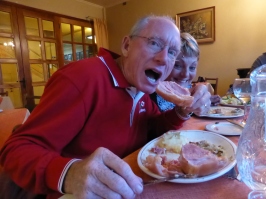
The drive out of Puerto Varas took us to the Carretera Austral Route 7 which followed the coast south to the first of the many ferries we will be catching over the next week. The clouds started lifting and we caught glimpses of the impressive snow covered peaks towering over us. We had been warned of the many roadworks along Route 7 which the Chile Government is seriously upgrading to attract more tourists to this spectacular part of the world with its unspoiled rainforests and challenging adventure opportunities. As we get closer to Hornopiren the stretches of new bitumen start becoming longer which is a bit of a relief and we didn’t find any seriously rocky sections of the old road. What a fantastic road it will be when it is fully sealed.
Hornopiren is described in the guide books as a frontier town which is pretty accurate. Someone with a bit of spare cash should be investing in the expectation of an adventure tourist boom when the road is sealed. Today it is fairly run down and as we drove through the town centre a crowd of locals were wandering around the recently burnt down remains of what would have been the largest store in town. A bit sad but hopefully they bounce back. As it was still too early to check in some if us drove out to the start of the National Park. Not easy to find with almost no sign posting and Garmin took us the wrong way we finally made it to find there were several walks starting with a 2.5 km walk along the river. A bit of exercise sounded appealing but the track was very muddy and tangled with exposed roots so we gave it away after a few hundred metres and headed back for a beer. Our accommodation at Hosteleria Catalina is pretty basic but easily the best option in town and our host is very excited to have us here – and it has wifi!
Hornopiren – Caleta Gonzalo
Posted on Jan 19, 2015
We are now in Los Antiguos having crossed the border into Argentina yesterday afternoon so our first chance to catch up with the blog. This post is taking us back to the trip from Hornopiren to Caleta Gonzales on 15 January.
On the gravel road to Hornopiren Mike’s car had been cutting out on the downhill corrugated sections so he spent quite a few hours working through possible fixes before concluding the carbs were flooding most likley due to the viton tipped needles bouncing off the seats in the float bowls. Hopefully a new set of float valves and slightly lower float level will make a difference.
Only 10 km of driving today with most of the day spent on ferries so the cars get a bit of a rest. The first ferry takes nearly 4 hours heading directly south. A comfortable cruise well sheltered from the open sea and views both sides of rain forests right down to the water’s edge and snow capped mountains above. Very similar to Norway except far more diversity and brighter greens. In our enthusiasm to keep moving we were almost the first onto the ferry – the smart locals and large trucks hung back knowing they would be first off for the 10 km dash to the next ferry. The rest of of us just waited patiently for another couple of hours. A good chance to chat to other travellers so we talked with Bob and Dave, cyclists from Wisconsin who had spent 10 years planning for their trip the length of the Carretera Austral to Torres del Paine. Even though they had well prepared bikes with all the high tech gear and tyres, riding on the loose gravel was still a big challenge and they come off a few times every day
Our overnight stop in the cabins at Caleto Gonzales in Parque Pumalin is just a few metres from our ferry destination. Parque Pumalin was the vision of Douglas Thompkins, the mountaineer, conservationist and founder of North Face who in 1989 sold the company along with Espirit which he jointly owned with his wife Susie. In 1991, he bought a large, semi-abandoned plot of land in the Chilean province of Palena. His objective was to protect the 42,000 acres, most of which was primeval rainforest from future logging. After moving to Reñihué to live full-time, Tompkins began developing plans for a larger park, gradually acquiring additional adjacent properties from willing sellers to form what is today the 700,000 acre Parque Pumalin. In total he has purchased about 2 million acres of forest in Chile and Argentina and is funding their maintenance until the governments can take them over as National Parks.
There is more information about the park at:
Caleta Gonzalo to Puyuhuapi
Posted on Jan 19, 2015
What a contrast to yesterday. The cloud is almost down to sea level with a steady drizzle. Easy to see why everthing is so green here. Breakfast at the Caleta Gonzalo lodge was a DIY affair because most of the kitchen staff didn’t start until after 8am. No shortage of home made bread and freshly laid eggs but a big opportunity for someone to take the initiative and sell proper coffee machines to every restaurant and cafe throughout the country. A bit of a mysteryhow Nescafé Instant has the market cornered when South America has the best coffee beans.
The road out took us through the southern section of Parque Pumalin with its lush rainforest. Everywhere we stop there are amazing displays of native fuchsias and other colourful plants right by the roadside The display continued almost to Chaiten, a fairly run down town which was almost devastated by lava flow from the eruption of a nearby volcano in 2008. Just a few kms before Chaiten, George and Cherie had the first puncture of the trip. They are running the same tyres as our car and several others – Michelin XM2 which we selected as the best compromise for wet grip and compliance over the rough stuff but a bit of a gamble compared with the much harder riding light truck tyres we used for the previous trips. They managed to find a replacement in Chaiten and we were relieved to see the piece of steel rod which caused the puncture – not a sharp stone.


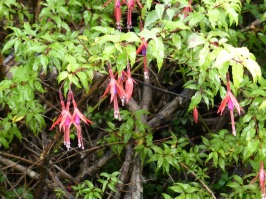

Our destination this evening is the very upmarket Puyuhuapi Lodge and Spa which can only be reached by boat leaving our cars on the other side of the lake. Built to take advantage of a series of hot springs, the attraction is its almost complete isolation and apart from a phone and single computer in the entrance there is nothing for guests to do apart from lie back and relax. We had hoped to get there early to do likewise but just 17km from Puyuhuapi we were stopped by roadworks which have closed the road from 2 to 5 pm. Missed it by just a few minutes! So here we are sitting in a long line of similarly uninformed travellers catching up with notes for our blog. An elderly gentleman came by after a while and apologised with his hand on his heart on behalf of the entire Chile nation for the inconvenience – a small consolation.
Puyuhuapi to Coyhaique
Posted on Jan 19, 2015
Puyuhuapi Lodge & Spar is located in Bahia Dorita which involved another ferry ride, passengers only. Cars were locked away in a “secure” compound, although it wouldn’t have taken much to scale the fence.
The hot thermal pools were a welcome relief after a tedious day and most of our group enjoyed a good soak. Another good thing was there was no Internet, so our bloggers got a night off!
But best of all we got to sleep-in the next morning (a rare treat) as the first ferry left at 9.30am. Lots of roadworks, slippery wet roads, amazing scenery, and road workers snapping away merrily as we drove by. I’m sure we have contributed to considerable time lost as the workers down tools to catch us on their iPhones. We hope we have brought some joy into their lives, and not added unduly to the cost of the roadwork. Today we managed to get past the roadworks, so that when they closed the road off for 5 hours we were already got through. Dave’s car, RIP decided to play up today just as soon as we were on the made road with about 140kms to our accommodation in Coyhaique. Lots of smoke, serious discussion, and soon RIP was being towed gallantly by Shiraz, under the guidance of Mike and Kay. Ross and Ian decide to take the short cut on gravel roads and were rewarded with amazing views and beautiful wildflowers right along the valley.
All three groups arrive in Coyhaique around the same time to find there was no record of our bookings. Fortunately the Tehuelche Patagonia Lodge and their English speaking manager Giesella found they could put us up, and even feed us all at such short notice. RIP is towed the last few metres up the steep driveway by one of the neighbours who has a Land Rover. Before long all the experts were under the the bonnet and by 9pm RIP was purring away happily.
Question: how many experts does it take to fix a blown head gasket?
Answer: I counted 6! RIP was just beaming after all that attention.
Most of the bloggers were happy as well as they found some wifi, some of course were under RIPs bonnet!!
Coyhaique to Los Antiguos
Posted on Jan 19, 2015
The overnight stop in Coyhaique was a bit of a blur with everyone working on RIP to get it ready for the next day. We had hoped to look up the couple we met in Puerto Varas, Asha and Arijit, who are architects working in Coyhaique. They had told us that the town along with several others in the south of Chile have been designated as free-trade zones with no taxes on many items to encourage regional growth. Pity we didn’t have more time to look around but thanks to Giesella and her kitchen staff who started very early we were off at 7 am in the expectation of a very long day with a border crossing into Argentina.
The first 100 km were covered quickly on smooth concrete roads but then turned to fairly ordinary gravel roads through more magnificent scenery for the remaining 300 km. For more than 200 km we hugged the shoreline of Lago General Carreras which became Lago Buenos Aires across the border.
Towards the end of the drive around the lake there were some seriously corrugated sections around steep uphill and downhill hairpin bends which challenged everyone, especially Mike whose car is still cutting out. Thanks to one of his blog responders we learnt there is a fix – spring loaded needles, pity they are on the other side of the world and he needs them now!
The border crossing at Chile Chico was a breeze, very helpful immigration and customs people who were patient with our poor Spanish so we made it to our accommodation in Los Antiguos with time to relax for at least five minutes before going out to dinner. We’re all feeling seriously deprived of vegetables and if our first experience of Argentinian meals is any guide we could be suffering from scurvy within weeks.
We have a rest day in Los Antiguos to catch up with car maintenance and other stuff and then back on the road southwards on Tuesday. Not sure where the next internet will be so there could be a bit of a blackout. All going well for now.
Los Antiguos to Estancia la Angostura
Posted on Jan 22, 2015
Another warm and sunny day in Patagonia. Just a slight breeze and already around 20 deg when we leave for our first day driving south on the famous Route 40. Right outside the hotel is a police check point and there seems no way around so we pull up and say ‘Ushuaia’ in response to the question from the very young policeman. No idea what he wanted to know but it seemed to do the trick and he waved us all through.
This is the recently sealed section of Route 40 and what a fabulous road. Billiard table smooth and the first section around the lake is one sweeping curve after another. After around 50 km we run out of lake and head into much harsher and more desolate country very similar to the Stuart highway around Coober Pedy. Instead of roos we have to dodge llamas which, apart from one who didn’t make it, seem to be smart enough to run away from the cars. Emus are replaced by their South American cousins, Rheas, and they appear similar enough to suggest very little evolution since Gwondana split up (about 20 million years ago?)
All the guide books recommend filling up at every opportunity in this remote area because the infrequent fuel stations regularly run out of fuel. Luckily no shortages at Bajo Caracoles described by Bruce Chatwin in his 1975 book “In Patagonia” as “a crossroads of insignificant importance with roads leading in all directions apparently to nowhere”. The best bit was that we were given the names of a few wineries to visit in Mendoza on our return trip – we’ve sampled a few Mendoza Malbecs so far and haven’t found a crook one yet.
There was much discussion the previous evening about the correct route to take to reach our destination, Estancia la Angostura. Our written instructions seemed to be contradictory and further complicated by inconsistent highway numbering. We stopped for a bite to eat at an intersection which we were fairly sure was the one we needed to take and our GPS agreed, contrary to the GPS in all the other cars. We were in the lead so elected to leave the tarmac and take the heavily gravelled side road. All looking good for around 20 km until the GPS suggested turning off at barely visible track which hadn’t been used for many years. Not looking so good now, but a few km further along we found a signpost to the Estancia about 4 km away on the banks of a river. A beautiful spot in today’s beautiful weather with white washed houses and farm buildings overlooking a wide wetlands area and the river in the distance. The house is well sheltered from Patagonia’s winds by a 20 metre range of hills directly behind. It would still be pretty bleak in winter though.
Estancias were originally sheep stations established in Argentina’s ‘Belle Epoque’ in the 1880s when Argentina had the greatest wealth per capita of any country in the world. In recent times they have turned to eco-tourism to help balance the books although this station is still a working sheep station in the hands of the family whose ancestors were some of a large group who emigrated from Croatia in the 1910s. The house was full of mementos and photographs of the early times including some showing deep snow all around the house. Mario and Antonio were good hosts and delivered a spectacular assido – a whole lamb barbecued on the fire burning in one corner of the large dining room. Lorraine was also well looked after with vegetables and empanadas and Antonio kept finding more bottles of pretty reasonable Malbec to keep everyone well lubricated.
Estancia la Angostura to El Calafate
Posted on Jan 22, 2015
Another beautiful day and we are off early for a long day to El Calafate and Perito Moreno glacier. Around 150 km on gravel through endless roadworks and the remainder on sealed roads with the occasional pothole or subsidence to keep us on our toes.
Perito Moreno is rated as Argentina’s #1 tourist attraction with most people staying in El Calafate before driving or bussing the final 90 km into the National Park. After the desolation of the highway El Calafate was a bit of a shock – hoardes of people and traffic jams in the main street which was lined with restaurants and tourist shops. On the way in we stopped for fuel and continued straight on to the glacier to catch the best early afternoon light.
The road in winds around the bank of the lake fed by the glacier and from around 10 km away we were rewarded with great views. 60 metres high at its face and 4 km wide, it is fed by the 13,000 ha Patagonian icefield and advances 2 m each day – almost impossible to imagine. The extensive walkways and viewing platforms allow visitors to see the glacier from every angle and watch as chunks regularly fall off with a loud crack. Very spectacular!!
Finding our hotel was supposed to be easy. We had an address and GPS directions – how could this be difficult? Ignoring the GPS direction to do an illegal left turn we found a steep track a little further along leading to a new four lane highway leading towards the lake. So far so good. The next direction was along a partly barricaded concrete road which ended with a 20 cm drop – not so good so we reversed and found a dirt road which wound around for another few kms before arriving at the very new Design Suites hotel stuck in the middle of now-where but with great views across the lake. Unfortunately our rooms were all on the wrong side so we got great views of a car park in a room like a sauna – the temperature control was turned all the way to cold but the architects had decided a hotel in Patagonia wouldn’t need aircon. And the dining room wasn’t working. Fortunately they offered a shuttle bus back into town so we could find somewhere to eat. The recommendation was to try La Cocina and enjoyed one of the best meals of the trip – thanks Ed!
El Calafate to Torres del Paine
Posted on Jan 22, 2015
Today is basically a transport stage back into Chile to see one of its biggest attractions. Torres del Paine is a huge granite outcrop in the middle of the Patagonian plains unrelated geologically to the Andes.
The drive was fairly uneventful apart from Navy Car taking a gravel road short cut which didn’t please everyone but we enjoyed it. At the end of the gravel road we met an intrepid reclining cyclist from France was doing an Argentine round trip on his solar powered machine. Pretty impressive technology and he was keen to keep everyone away from shadowing his solar cell array during the stop to maximise charge for his next leg. The cycle even had a small wind generator to capture energy from the Patagonian winds whenever he stopped. And today the wind was blowing – dark clouds and a howling gale which nearly blew us off our feet every time we stopped.
At our next photo stop we met a couple of motor cyclists who were riding from Ecuador to Ushuaia. They rode the Silk Road in 2012 and were impressed that our MGs had done the same trip in 2010. Amazing camaraderie among adventurers of all sorts which never ceases to amaze us.
As we get closer to Torres del Paine the outcrop becomes even more impressive – lots of thing to do here but we are off at 5:15 am in the morning to catch a boat ride to the next glacier. The pressure is on!
Torres del Paine to Punta Arenas
Posted on Jan 25, 2015
A very early start, cars rolling at 5:15 am to drive through the National Park to Lago Grey where we have booked a 3 hour cruise to the face of another glacier. Still very dark and we have a Lucas electrics moment when the headlights start flickering. No time to find what has shaken loose over all the corrugations so fingers crossed they won’t die completely before sunrise.
Soon the first sunlight hits the 3000 m peak of the Torres and we are rewarded with a spectacular show as the icy slopes gradually light up followed by the chiselled rock faces. The closest experience in Australia would be sunrise at Uluru except we are winding around a gravel road beside the lake so the views are continually changing.
Right on schedule we roll up to the Hotel to pick up the cruise tickets then stroll down to the beach to enjoy a packed breakfast while we wait for the ship. So warm already, we later learn that there are only 6 or 7 sunny days each year like this with no wind to chop up the lake – how lucky is that! On many days the cruise can’t operate because winds across the lake can reach 180 km/h. A normal day is just cold and drizzly.
From a distance the glacier looks unimpressive. All we see are two icy arms either side of a large island but as we get closer the 20 m jagged faces dominate the view. The ship was built as an icebreaker so it has no problems running into the floating ice floes which have broken off the face so we get to within 100 m of the face to admire the brilliant ice sculptures.
The rest of the day was a bit of an anti-climax – a return trip through the National Park and then on to Punta Arenas for our overnight stop. Punta Arenas was a bit of a pleasant surprise. I could recall landing at the airport about 20 years ago on a return trip from Brazil in the days when 747s didn’t have the range for a direct trip to Auckland against the Pacific headwinds. It was bleak and windswept and the terminal was nothing more than an old Nissen hut parked in the middle of nowhere. The city itself has grown from its early days as a penal colony and shipping port into a vibrant university town and everyone was out watching street performers of every description. About the size of Bendigo but a lot more action.
Punta Arenas to Ushuaia
Posted on Jan 25, 2015
No dramas getting away and down to the ferry terminal for the trip across the Magellan Strait and back into Argentina. Way too cold to brave the deck so we cram into the cabin area alongside three young guys who are travelling from Atacama in the north of Chile to Porvenir for a soccer tournament. These guys had serious attitude but with a great sense of humour and one spoke reasonable English. They were playing Chilean music and Lorraine started to groove along so the youngest one, Diego asked her to dance with him which she did with style. Another example of the spontaneous affection we are enjoying.
It would be interesting to learn how Chile managed to secure a large lump of the southern part of Patagonia and effectively cut off any possibility of a direct land route to the other piece of Argentina where Ushuaia is located. A least it keeps the immigration and customs people at San Sebastian pretty busy.
The road is called ‘Ruta Fin del Mundo’ or Route to the End of the World. It seems very appropriate for the treeless windswept plain skirting the Atlantic Coast for the first couple of hundred kms but then we were back into mountain ranges and vast forests of Antarctic Beech for the final 100 km heading west into Ushuaia along the 55 deg parallel.
Somehow the mayor had heard about our visit so he sent along his deputy and the tourism officer to greet us in the plaza. Lots of interest from all the bystanders, many of who were also travellers from other parts of South America. A few nice speeches and we were off to our quaint hotel located at the end of a long dusty track about 5 km out of town. Quaint in appearance and that wasn’t the only thing………..
I had hoped to get good news about a package of car parts which Simon had shipped a couple of weeks ago but are now stuck in Buenos Aires customs. A job for tomorrow!
The end of the world – Ushuaia
Posted on Jan 29, 2015
The town claimed to be the ‘end of the world’, Ushuaia normally has around 70,000 people but the population grows at this time of the year, the peak season for Antarctic cruises and adventure seekers. From 1884 to 1947 Ushuaia was a penal settlement, Argentina’s equivalent of Port Arthur, and it wasn’t until the 1950s that there was even a road into town. It then became a naval base, with signs around town suggesting that ownership of the Malvinas is still an issue. Now it is primarily a container terminal and a base for tourism – nearly everyone we meet in the streets has come here from somewhere else.
Our hotel is around 5 km from town and right on the water’s edge and we have three nights here to catch up before we head north again. It must be a challenge to walk from the front door to your car in a howling gale but we are blessed with fairly calm weather for the three days stay in Ushuaia. Don’t know why we brought the big bag of warm clothes and thermals, most of the time we are walking around in short sleeved shirts.
On Sunday we have arranged to use a local garage run by Carlos to service the cars. Floor space is fairly tight but 3 hoists accessible after he has moved his Fiat race car with a wild cam and completely open exhaust out into the street with much revving. His neighbours must love him. Nothing loose underneath despite the pounding and a good opportunity to grease all the suspension bits ready for the next stages. The headlight problem turned out to be nothing more than a faulty earth for the new relays installed shortly before we left – apologies to Lucas, not your fault this time.
Our trip had aroused considerable interest among the local tourism people so each evening we were invited to park our cars in the centre of town which attracted lots of attention and even brought out the local TV news crew – more on this later.
As well as being a jumping off point for Antarctic and local cruises, Ushuaia is also a great place to sample seafood with King Crab being one of the specialties. Tough work but someone had to do it..
Ushuaia to Rio Grande
Posted on Jan 29, 2015
Only a short day’s drive back to Rio Gallegos today so we delayed our departure until noon leaving time to visit the local museum dedicated to the indigenous Yamana people. They arrived around 6000 years ago with their ancestors having made the long migration from Central Asia via the Bering Strait and somehow managed to survive the harshest conditions in Tierra del Fuego – the Land of Fires named by early sailors who observed the fires they burned to keep warm. The Yamana managed to survive a semi nomadic existence living off mussels, cormorants and the odd beast while wandering around completely naked – apparently this was preferable to wandering around in constantly wet fur clothing. The one concession to the weather was that they spent a lot of their time squatting so they ended up with baggy skin around their knees and a serious case of pigeon toes. Not really a good look. All went well until some well meaning missionaries decided they needed salvation around 1840. They may have survived the salvation but unfortunately most didn’t survive the introduced diseases so today there is only one direct descendent left – an 84 year old woman named Catalina who still lives in Ushuaia.
The drive to Rio Grande retraced our steps on the way south so no surprises and a good road all the way. There is only one town along the way and it is supposed to have two attractions. The first was easy – La Union Panaderia is reputed to have the best pastries for miles around, in fact the only pastries for miles around and everyone and his dog were there. The second attraction was a bit of a mystery to everyone. Tolhuin is supposed to have the southernmost race track in the world but nobody we asked knew anything about it. A pity, especially for RIP which only last year got to drive around the northernmost race track in Norway.
Must have been a quiet news day today because the Patagonia TV channel had a story about the 8 Australian couples who tour the world in their 1961–74 MG cars. Caused quite an excitement in the Italian restaurant where we were eating this evening when the other customers made the connection with the MGs parked outside.
Rio Gallegos to El Chalten
Posted on Feb 1, 2015
As we are leaving the Hotel Patagonia a very excited guy came up to us to tell us he was also travelling Ruta 40 in an old car but his was a 1920s Ford – I’ll leave it to my ex-Ford friends to identify the year and model. A short detour via the waterfront which is totally deserted this morning but gets more interesting towards the end where there huge piles of rusting machinery from earlier eras. In one yard there are rows of old boilers and steam engine parts in advanced stages of decay. Maybe an opportunity for someone to come in and preserve the history of Rio Gallegos in a museum?
We then rejoined the main highway out of town and were amazed by what appeared to be recently installed overhead lighting. Elegant poles and light fittings which continued for the next 26 km! How can a country with a debt problem like Argentina’s commit to a folly like this?
Apart from one lonely cyclist there was nothing for the next 200 or so km – no towns, no cross roads, just barren brown pampas. Lago Argentina looked just as impressive, this time heading northwards. On the way down we had passed right by the lonely hotel at La Leona but this time we stopped to find out more about its connection with celebrities. Butch Cassidy and the Sundance Kid hid here for a month after robbing the Bank of London in Rio Gallegos in 1905 and lasted another 5 years before being killed in an epic shootout in Bolivia. We think of Ned Kelly as a bushranger who got around a bit but he was a rank amateur compared with these guys.
El Chalten is another Mecca for trekkers but tiny compared with El Calafate and less developed. No phone coverage, just one ATM and mind-numbingly slow internet. One guy we met had spent two days trying to send an email. The big attraction are the Fitzroy ranges – 3400m high with jagged ice and snow covered peaks. The town is full of young people, mostly serious walkers, which is pretty refreshing compared with Australia where most walkers are people just like us. The town has a real hippy feel to it so this evening we find a restaurant called Techado Negro with good vegetarian options. Good food and very drinkable malbec at $10 a bottle but the table full of noisy Americans just behind us was a bit of a downer. The guy at the next table leant over and asked where we from – once he had established we were Australians, we jointly reflected on how much space people from different cultures could dominate.
El Chalten
Posted on Feb 1, 2015
A ‘rest day’ today so a group of us head up the hill for a 3 hour walk to Lago Capri. One for Bob Watson, as we are heading our of town there is a pretty reasonable Renault Dauphine parked by the road. And not far away a nice Peugeot 404 along with some very beaten up 504s.
Great to stretch the legs after 3 days of driving and spectacular views as we wind around the side of the mountain. Long open stretches with views up the valley towards Lago del Desierto where Dave and Laurel have driven to see the glacier and then back into thick forests of Antarctic Beech. Finally we climb over the saddle to look over Lago Capri with Mt Fitzroy shrouded by mist in the background.
We were lucky to beat the rush because there was a steady stream of climbers coming up as we descended and the wind had really picking up. Here is one for Milly and Jack – a couple were using a llama to carry their hiking gear up the hill. They weren’t making much progress because everyone wanted to photograph them. By the time we reached town there was a gale blowing down the main street and we were expecting the tin roofs from the many half finished houses to start flying around.
A few car repairs this afternoon. Our hopes of shipping parts into Ushuaia fell in a big heap when with the help of Billy Boorman from the MG Club in Buenos Aires we tracked down why the parts were still held up. It turned out that tighter restrictions had been imposed on the importation of auto parts from 1 Jan and importers had to be either licensed or use a broker. The costs to use a broker and pay the import duties were prohibitive so Simon and I decided to send the parts back to Australia and hope that they would arrive before he left to meet us in Lima. Fortunately the master cylinder problems are proving manageable but we need to find another solution to the sticking carb throttles. I hadn’t picked up that the throttle shafts were a little worn when we left Australia but became much worse with all the dust over the past weeks. In Ushuaia, I attempted a cure by building up the shafts with Araldyte but this didn’t last and the drive up to El Chalten became pretty difficult. Mike Herlihy to the rescue with his very expensive liquid metal made by Wurth. Miracle stuff which hardens in ten minutes and sets to a rock hard surface overnight. I finished the job off this afternoon and on the short drive down to get fuel this afternoon it seems to be working well. We’ll find out tomorrow whether this is going to last the distance.
El Chalten to Perito Moreno
Posted on Feb 2, 2015
A beautiful rainbow across the mountain greets us as we leave Hotel Lunajuim and its very helpful and enthusiastic staff – they were all quite emotional when we left and wished us safe travels.
This was a fairly long day with nearly 600 km to cover most of which we remembered from the trip south. This time we took the long way around through Gobernador Gregores to miss the gravel section we had taken to get to the Estancia and from then on it was all sealed. The government is progressively sealing the entire length of Route 40 presumably to attract more tourists but in these southern sections there are still long periods where we see no other cars. There are long, long straight sections, up to 20 km or so which become mesmerising after a while. We were just reflecting on the risk of nodding off and drifting off the road onto the rough gravel verges when we saw a Fiat pick-up well off the road with windows and roof smashed – new skid marks and a body lying beside the car didn’t look good. The woman driver was in shock and wanted us to help the guy who we assume was her son and appeared to have been thrown out. Luckily he only appeared to have a cut on his head and grazes but no breaks. The next to arrive were German tourists, one of whom was a doctor who confirmed the diagnosis. We found a bag of clothing in the Fiat and made sure he was warm and shielded from the wind and left him with the doctor and the woman. No mobile signal for miles around and the next town with police and a hospital nearly 300 km away so the best we could do was take her note to the nearest stop off with phone service – fortunately we found a local guy who had also seen the accident so we were able to leave him to sort it out. Very sobering and we had a good discussion at our evening briefing to remind everyone of the need to rest or change drivers if they felt tired.
A surprise awaited us at our Perito Moreno hotel – another Australian traveller, Giles Cooper, was there to greet us. Giles is a friend of Ross and Shez and on his way south through Chile so he popped across the border to catch up and share experiences of his trip from Alaska through the US and Central America. This time he is driving a Land Cruiser but his previous trip north to Alaska was in a Lotus Elise. He wanted to be the first to drive a Lotus to Alaska but after the trip took it straight back to Australia afterwards to buy something more practical. Lots of good advice from Giles about crossing borders without having to pay bribes and minimising risks of accidents with the crazy truck drivers in Central America. Sounds just like parts of Africa…
Perito Moreno to Gobernador Costa
Posted on Feb 3, 2015
Hooray, the sticking accelerator is fixed at last. The sticking throttles in each of the carbs were finally fixed with liquid metal but the cable was still binding. A brand new cable fitted just before the car was shipped turned out to be faulty so I re-fitted the old spare which had already completed the Cape to Cairo trip and it was much better. Feels like a new car!
Still in Patagonia and still fighting side winds all the way we stop off at a tiny settlement called Los Lamariscos in the middle of nowhere. There were all the signs that it was once a fuel stop but now they depend on travellers stopping to see their modest museum or to buy a snack. The lady who owns it is the granddaughter of the guy who founded it in 1938 – she was very excited that a bunch of classic cars had stopped and came out with photographs of a group of rally cars who had visited a couple of years ago. Tough gig!
Our destination at Gobernador Costa is described as “a one-horse town” or a “small barren windswept settlement”. A bit harsh but our biggest challenge was that the receptionist said there was no record of our booking. A bit more probing and it seemed that there was an enquiry but no money had been transferred from the travel agent. Sunday night and no chance of talking to the agent so lots of haggling finally resolved by me handing over a credit card as security. What made it really tricky was that the town has no mobile phone coverage, no internet and the hotel had no ISD dialling facility so we couldn’t call the 24 hour hotline to our travel agents in Chile. Things didn’t seem much rosier in the morning until Ken found a guy who could speak a little English and we established that the money had been paid and we were free to go with credit card untarnished. Just another one of life’s little challenges in South America. Amazing that we had few problems with internet of mobile coverage right through Africa and on the previous trip through China and Central Asia but South American communications are still back in the 1980s.
Gobernador Costa to Esquel
Posted on Feb 3, 2015
Hotel accounts resolved we got way after coffee and croissants at the local servo for the short drive to Esquel. The plan was to get there in time to book tickets for the 2:00 pm departure of the “Old Patagonian Express” . This title was bestowed by Paul Theroux, one of our favourite travel writers on his trip from Boston to Patagonia. The local name of the train is “La Trochita” but the new title also now appears in some of the Argentine documentation.
La Trochita runs on a narrow gauge railway running from Ingeneiro Jacobacci in the north down to Esquel. Construction started in 1922 and completed in 1945 it ran for 402 km, initially just for freight but later as a passenger service taking 15-20 hours connecting with the broad gauge service to Buenos Aires. Tiny hard seats and rattly windows with the only concession to comfort being a small wood stove in the centre of each carriage. The locomotives in use today were built by Baldwin in the US. In 1990, all railway operations were closed in Argentina as an austerity measure but somehow La Trochita survived and today it operates as a tourist service from Esquel to the next town, Nahuel Pan, a round trip of 21 km. There is a small museum at the Esquel station showing videos of the train in its heyday battling snowdrifts and winds – at some stage the entire train was blown off the tracks by the Patagonian winds but they managed to resurrect it and get it back into service.
Tonight we are staying in a bed and breakfast called Canela with our generous hosts Jorge and Veronica. A green oasis with beautiful gardens and comfortable rooms on the edge of the Patagonian pampas. Very welcome after some of the more austere accommodation recently.
Esquel to Bariloche – near disaster!
Posted on Feb 4, 2015
Over breakfast at Canela B&B we learn more about our hosts Jorge and Veronica. Before moving to Esquel 20 years ago Jorge Miglioli managed a large sheep property near Los Antiguos. Veronica is now a painter and Jorge an author and photographer. His books include one on the history of the Welsh immigrants in Patagonia and another on La Trochita, the narrow gauge railway we travelled on yesterday. Unfortunately now out of print but we found a couple of copies on Amazon.
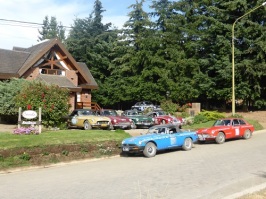

We had a lunch appointment about 180 km away in El Bolson with Klaus, the German guy who had organised insurance for our cars just when it all looked too hard. He is a motor bike adventurer who looks right at home in El Bolsen which has a reputation as fairly alternative. The lunch was booked at Otto Tipp micro-brewery, just a pity we had to drive further and had to decline the beer tasting option to accompany the rather generous meals. As we were leaving an even more alternative lady drove past in the world’s most battered 2CV van. An absolute barn-find (the van, I mean)
For the final 140 km into Bariloche we are surrounded by serious mountains in the shadow of the Andes and the sky ahead was ominously dark. RIP stopped to put up the hood and then the rain came down. Lightning, thunder and incredibly heavy rain. Casper and Shiraz decided to pull over and we followed as the tail car. No let up for at least half an hour before Kay let out a shriek – ‘get moving, there’s a mud slide coming down the cliff right alongside us’. We just got the cars out in time before the mud and rocks blocked the road. Fortunately the rain had eased slightly so we covered some distance before coming up behind a couple of cars blocked by another mud slide. Mike decided we could make it through if we could dodge all the rocks and tree branches but just a few more kms on there was a long line of cars blocked by another slide. This one was a bit more serious, a roaring torrent of rocks and mud more than a metre deep right across the road and more than 30 metres wide. Even a Landie wasn’t going to get through this.
Around 6 pm the police and emergency people started arriving telling everyone it could be 5 or 6 hours before the road could be cleared. The thought of driving down the mountain in the dark wasn’t very appealing but we didn’t have a lot of choice. A grader turned up and made a few attempts to start clearing but it wasn’t up to the task at all. Finally a low loader arrived with a bulldozer and the police said it would only be an hour, two at the most. We settled in for another wait when suddenly everyone in front started moving and we were off – Lorraine hardly had time to get the iPad out but managed to get a few quick pics before we were through. Meanwhile down at Bariloche the other five crews received mixed messages – from our end Mike had managed to get a message through before the others were out of range so at least they knew we were safe. Then they heard that we had been diverted back to El Bolsen and wouldn’t make it through until the next day. Everyone was very relieved when we finally arrived around 10 pm but we were a bit late for the complimentary welcome drinks and had to buy our own…
It’s all my fault for suggesting to Sue over breakfast that the trip was starting to get a bit too easy and we needed some excitement…
Bariloche and a brush with the law
Posted on Feb 7, 2015
After our ordeal yesterday the thought of spending a relaxing day wandering around Bariloche and the picturesque Lago Nahuel Huapi was appealing. Beautiful clear skies, ideal temperature and no pressing schedule to meet.
We ventured out to explore the town and stock up on some provisions to discover that all the holiday makers were in town, every second person we passed was a tout who could offer the best exchange rate and if you liked chocolate then you were in luck. Bariloche is Argentina’s chocolate capital!
In the afternoon we teamed up with John and Ross Bastian (Goldie) and Mike and Kay Herlihy (Shiraz) to drive the recommended lake route which Ian had learnt was used for Argentina’s Millas 1000 – their version of the Mille Miglia . We hadn’t gone too far when John was pulled over by the local police. It turned out that earlier in the day the Bastian’s had had a minor altercation with a local car and its driver had become very aggressive so they made a hasty retreat. The other car had been in the wrong but they weren’t prepared to stick around and discuss it It appears that the driver was a cop so there was a general alert out to find a mustard coloured MG. As John was questioned more and more police arrived, some with lights flashing, greeting each other with the traditional handshake, hug and kiss. They all seemed to be having a good time, except of course for John and Ros. Those looking on would have thought it was a major drug bust.
Unfortunately John had left his car insurance papers at the hotel and this was causing the concern. As there were three cars, we left the Herlihys there to support them and went back to retrieve the missing insurance papers. This solved everything! The whole ordeal took about an hour or more and John was imagining a lonely police cell. All they wanted were the insurance papers so their mate could make a claim. A good lesson to us all to have our insurance papers in the car at all times.
It seemed appropriate to have a chocolate fix to restore blood sugar levels and put a smile back on John’s face. After several hot chocolates, some Argentinian chocolate cake (filled with caramel) and delicious chocolates we all agreed Bariloche lived up to its reputation.
Our accommodation Design Suites came with its own spa. Generally we don’t have the time in the evenings to have a good long soak – with fixing cars, evening meeting/ debriefings, washing all the smalls, etc. so we decided to dine in and make use of the spa. Champagne seemed appropriate too!
Bariloche to Zapala and a few challenges for Blue B
Posted on Feb 7, 2015
Not a challenging day today (we thought). A scenic drive along the seven lakes route from Bariloche to San Martin de Los Andes, winding our way around aqua blue lakes, the Andes always in the background and as a bonus the roads were paved.

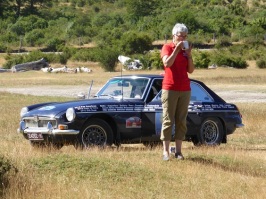
Blue B had other plans for us. For a few days Ross has been having issues which he felt he had resolved after long hours working under the bonnet whilst we were enjoying the sights of Bariloche. Blue B hummed along nicely for the first 100 or so kms when we heard Ross’s posh British voice announce over the CB “Sorry guys I’ve lost power – am pulling over”. Fortunately there was space for our convoy on the side of the road just outside San Martin de Los Andes.
This time it looked more like a fuel blockage, the experts gathered and Blue B was again the centre of attention. It was decided to split the group and we, along with Peter Carthy (Green Car) and the Herlihys (Shiraz) stayed back to assist whilst the others headed off to Zapala.
The day was beginning to heat up and this was the first of many road side pauses as Blue B struggled to get fuel through. The guys rocked her from side to side, cleaned filters, replaced fuel pumps, topped up with spare fuel, got rid of old fuel and various other attempted fixes. In the end after gallantly struggling another 100 or so kms it was decided to get out the tow rope for the last 60 kms. Navy car took on the role and together we made it to Zapala a good two hours after the first group. Ian said it was a little unnerving looking in the rear view and seeing a blue car tailgating him at 100 km/h. The last long hill was really steep so it was back to 2nd gear and keeping a watch on the engine temperature. Daytime temperatures have been in the high 30s and expected to get hotter as we head North.
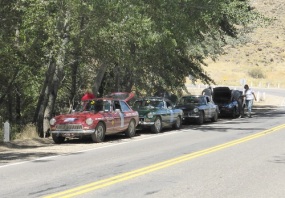

After all the work on Blue B the problem was not resolved and some refreshed drivers would need to look at her again in the morning.
At our debriefing that evening there were two groups, those who were trying to understand Blue B’s problems and provide a fix, and the rest of us who wanted the answer to the more important question “Where were we going to eat!”
We wandered down town with Ros and John Bastian and were assisted by a helpful local who discovered us studying a map on a street corner. We explained we were looking for dinner (at around 8pm which is far too early for most Argentinians) but he provided us with a name and location and off we went. Los Familias Restaurant was empty when we arrived, but we were welcomed, and soon we were tucking into traditional fare of grilled meat (and chicken), potato chips, salad and washed down with a very satisfactory local Malbec. The vegetarian of the group was very happy with her vegetable crepes and mushroom sauce. By the time we departed at around 9.30 the restaurant was beginning to fill with locals and really buzzing.
A short drive tomorrow – but first Blue B must have her fuel problem sorted out.
Zapala to Chos Malal
Posted on Feb 7, 2015
We organised a late checkout from our hotel Hue Melen so that Blue B’s fuel system could be sorted. Peter, Ken, Mike and Ross worked the early shift starting around 6.30am. They replaced nearly everything in the fuel and ignition systems and by 9.30 all was back together again, Ross had lost his concerned look and better still, Blue B was purring away again. We were ready to hit the road for Chos Malal only 190 kms away, still not sure what the real problem was.
The stark desert like landscape we were now travelling through was such a contrast to the chocolate box landscape of Bariloche. The temperatures in and outside the cars were soaring but fortunately we had smooth paved roads to travel on, side windows were open and life was good.
And no breakdowns today – fingers crossed, touch wood!
Chos Malal is a pretty little oasis of a town which pops up out of the desert and was a welcome sight. We arrived around1.30pm and we were hot. Could we push our luck for an early check in? We were in luck, and this provided the perfect opportunity for Navy Car to have its master cylinder rebuilt. Ian and Pete pulled it apart, cleaned everything, stretched the spring to help the piston return and put it all back together. Hopefully now the brakes will be consistent and not alternating between a full pedal and a half pedal – we may even get rid of that annoying squeal which happens when it’s hot and the brakes weren’t releasing properly. Maybe now I will be brave enough to drive to give Ian a break!
Some of us discovered the ice cream shop which was part of our Hotel Don Costa Hosteria. Argentina is famous for its ice creameries – and such a luscious treat on a hot day!
Chos Malal to Malargue
Posted on Feb 7, 2015
Today we have 333 kms to cover including around 100 km of roadworks and unpaved roads. By day’s end we will have travelled nearly 3000 km along Route 40 from Rio Gallegos and can’t help being impressed by the investment being made to make it a first class tourist road. It doesn’t appear to carry much truck traffic, most of the trucks use the highways radiating out from Buenos Aires and the other major coastal cities. Route 40 just happens to link all the interesting old towns following the path taken by the original settlers who arrived from Peru and Bolivia. They and the new towns which have sprung up as ski resorts and bases for adventure on the eastern side of the Andes are a tourist mecca. When the road it fully completed it should attract tens of thousands more tourists which should be good boost to the local economies. For people who love driving, the roads are among the most exciting and challenging in the world especially where we are today as we get closer to the Andes. In some distant future landscape, the government may spoil the fun by enforcing speed limits and other road rules but for now all speed limits and double lines are treated by the locals as discretionary only. Fortunately most Argentinian drivers are pretty sensible and way ahead of the standards of driving expected as we head into Bolivia.
Volcanic activity has formed an extraordinary landscape which is so different to any we have encountered so far. We climbed up steadily winding our way around treeless hills covered in stubbly salt bush interspersed with rocky outcrops to around 2000 meters. In the distance we would glimpse views of the Andes proper. Unfortunately we also discovered the unpaved roads which included some of the most tortuous so far. Occasionally we came to an oasis marked by tall poplar trees as the Rio Grande wound its way through the valley. We kept criss-crossing the Rio Grande for a half an hour or so until we got to a small bridge over a deep gorge with steep cliffs formed from black volcanic rock. Nearby there were half a dozen small shrines, in one of which a candle was still burning. Another featured a battered number plate from a car – was the driver careless enough to lose his life at this spot or is there another story? At mid-morning we said goodbye to Patagonia and drive into the province of Mendoza.
At one of our photo stops we met biker Ron, a Californian who told us he learned to ride his BMW when was 68. He is still 68! Ron wasn’t a big bloke and struggled to keep his bike upright on the steep gravel surface. He said he had lost count of the number of times he had dropped it. He is travelling a similar route to us and has seen us a number of times along the way. Ron had owned two MGBs and a TD, then changed to Triumphs which he said weren’t much more reliable. He thought we were totally crazy!. We thought the same about him! We hope to catch up again as he would have some stories to tell.
Malargue is described in Lonely Planet as “a mellow little town that is a little rough around the edges” and is a base for Las Lenas, one of Argentinia’s more upmarket ski resorts. Our hotel is a little up-market and uninteresting compared with recent nights but perhaps we are just being prepared for the Park Hyatt in Mendoza, our next stop.
Malargue to Mendoza
Posted on Feb 8, 2015
Last evening we gave our soulless hotel a miss and went back into town to eat at a cafe Mike had seen on the way in. It was the first time we had seen anywhere with outside tables and chairs so we settled in as the sun started to go down and chatted to a few people who came over to check out the cars . Dave was interviewed by a young lady from the local paper who had seen us come in and she later called by and gave him a box of locally made chocolates. Our waiter was a young chap who seemed to take in the entire order for drinks and meals from our table of 8 without writing anything down – the Argentinian way. We ordered a Sauvignon Blanc and a Malbec but were presented with a Rose. Tried again and got a little closer before we finally worked out that they didn’t actually have anything on the wine list and he was just checking what we might like instead. It worked out ok in the end but after most of the meals were delivered he told Lorraine that Tuna salad was off and what would she like instead. Another half hour passed punctuated by John going inside and reminding him that Lorraine’s meal still hadn’t been delivered. I had also made sign language through the window whenever he went past and he gave me the thumbs up. Finally her meal arrived but by this time it was blowing a gale and we realised why outside dining was a bit of a challenge. We paid the bill including a less than usual tip as an encouragement and as a parting gesture he presented John with a bottle of Chardonnay!
Today we have what looked like a straight forward 420 kms run to Mendoza. Just one potential hiccup, we decided to take what looked like a paved detour around San Rafael which is a fair sized town. Sure enough there was a Garmin moment when we were lead down ever more minor tracks until we came to a group of houses. I asked one of the residents whether the road would take us through to Mendoza to which he replied no, we needed to go back and take another road but my Spanish wasn’t quite good enough to be sure where this was. Then another chap arrived and said no problem, the track would take us to Mendoza. Just like one of those stories about asking directions in Ireland. Being trusting souls we took his advice and headed down the track through the tip to find a fast flowing river blocking our way. Of course all the locals had a big laugh when we had to turn around and come back. We were just pleased we had given them something to brighten up their lives and talk about for years.
Our lunch stop was in a town where we rejoined route 40 – this also by-passed San Rafael but looked like a pretty rough gravel alternative so we had given it a miss. Everyone heard we were in town and came over for a look. One guy was particularly interested in the engine in Pete’s car so I asked if he was a mechanic – no he said piloto de carreras, which I took to be a race driver. I showed him some pics on my phone of Fangio signing the wall of the garage in Albert Park we had come across recently which had been used by many of the Grand Prix drivers in the 1950s. He was very excited and pointing at me said ‘Alan Jones’. He was even more excited when I panned through a few more pics from the garage and found Alan Jones signature – Alan must have been a boy at the time.
Mendoza – MGs and Malbec
Posted on Feb 13, 2015
Arrived in Mendoza mid-afternoon on Sunday to find everyone was somewhere else or enjoying a siesta – a city of more than a million people with almost deserted streets. We were expecting to meet up with the MG people who had driven up from Buenos Aires and also a few people from the local Classic car Club but it took a while to track them down. Meanwhile we went for a stroll around this beautiful city with its tree-lined streets and plazas. Well away from the Patagonian winds now so there are lots of cafes with outdoor tables to choose from.


Finally the MG Car Club people arrive with a rasp of pre-war exhausts right outside the Park Hyatt – Horace and Carlos in their red and blue 1934 J2s, Mario and Maria-Laura in their replica Q-type and Raul in an MGB. Lots of car-talk breaking down the language barrier – Hector and Maria-Laura performing the interpreter roles when hand gestures failed. A few drinks at the bar on the corner then off to a nearby restaurant along with Leo and Elle, Patricio and Willy from the Mendoza Classic Car Club. A great evening with a nice presentation from the BA guys.
In the morning we have a few hours to catch up on some car maintenance – in our case to find out why the cooling fan failed, again, and to fix a door latch which fell apart on some rough roads a few days ago. All fixed by 12:30 when we are invited to drive in convoy to a nearby winery for lunch. I could get used to a city like this with wineries only a few kms from the city centre.
Nieto Senetiner winery is one of the oldest wineries in Mendoza and dates back to 1888. Very polished with beautiful gardens and vineyards right next to the outdoor dining area where we enjoyed our best meal since arriving in Argentina – a lunch lasting nearly 4 hours! The plates of Argentinian beef just kept arriving. We haven’t found the part of Argentina where these cows are raised, occasionally we see are a few goats but most days there is no stock to be seen at all. Mendoza is the home of Malbec and the one from this vineyard was the best we have tasted. They also offer a Cab Sauv and a grape we haven’t come across before, Bondara. Tasting and looking very like a Barbera. We were amazed at the generous irrigation, water flowing freely in open channels along each trellised row. So different from Australia where every precious drop is precisely metered to the vines.
At first blush Mendoza seems to have everything a winemaker needs; good soil, warm and dry summers with little risk of rain at the wrong time, plenty of sunshine and most importantly, abundant irrigation from the rivers flowing from the Andes. The only real concern is that the snow fields are shrinking each summer and their reservoirs are drying up. A problem for manana….
Mendoza and MGs
Posted on Feb 14, 2015
After the very enjoyable lunch yesterday at the winery there was some serious sightseeing to do today with recommendations from our new friends from the Mendoza Classic Car Club.
They suggested driving west on the highway linking Mendoza and Santiago Chile to catch views of South America’s tallest peak, Aconcagua. At 6960m it is not only South America’s tallest but also the tallest outside the Himalayas so we weren’t about to attempt a climb to the top! A little further on and right on the border with Chile, there is a steep track off the highway to the statue of Christo Recentor de Los Andes or Christ the Redeemer of the Andes. Not sure why the Andes needed redeeming but there you go. The climb to the top at 3800m was fairly amazing especially when viewed from the bottom and seeing the tiny cars and buses crawling their way up around the dozens of hairpin bends. It was 1st gear all way and fortunately ascending cars had right of way, because the gradient was too steep and the air too thin to attempt a restart without overheating the clutch. Amazingly all the MGs made it to the top! Most of us noticed the effects of low oxygen levels too – good training for Bolivia.
On the highway the pre-war cars were amazing, keeping up with traffic on all but the steepest hills and passing trucks at 110 km/h while bouncing all over the road on the rough bits. The drivers looked totally exhausted after the 400 km round trip in their tiny cars and tomorrow they will do it all again on their drive back to BA.
On the return trip we stopped off at the Aconcagua National Park hoping to get a better view but it was now covered by cloud so the tiny glimpse we had in the morning was the best it was going to be.
What a terrific opportunity to develop such a strong friendship between enthusiasts of both countries! We look forward to them visiting us in Australia and all of us would like to come back to Argentina!
Mendoza to La Rioja and Cafayate
Posted on Feb 15, 2015
A longish day to cover the 600 km to La Rioja. The lush vineyards of Mendoza were left behind and replaced by huge flood plains covered with thick scrubby salt bush – another reminder that Argentina and Australia share the challenge of having such vast areas of non-arable land. A trouble-free run for everyone with the towering rock formations of the Talampaya National Park being the only highlight. A relaxing beer at the tables fronting the town plaza was a good way to end the day although there was a bit of competition from the local motorcyclists doing endless laps around the plaza. All good fun.
Leaving La Rioja the next morning our GPS took us on Route 75, a narrow winding road through the best part of town with beautiful houses and gardens behind big fences gradually replaced by lush green vegetation before we were out of the gorge and back in on the hot, dry plains.
A little further along there was a less successful Garmin moment leaving Santa Maria. As usual there were no directions to the next towns and we worked out that the GPS wanted to take us on the old Route 40 to the west rather than the new high level road. In the confusion of one-way streets and against the advice of helpful locals, Ross decided his back-up GPS loaded with an alternative set of maps had it all sorted and headed bravely into a wet and wide river crossing which quickly turned to thick mud. Woops… Pete wasn’t going to turn down a challenge and called for everyone to get their tow-ropes out to span the 30 metres back to dry land. With a bit of shoving and pushing and a minimum of burning clutch smells, Blue B was released from the quagmire. Having come that far the collective decision was to continue on the old road which turned out to be far more interesting although a bit slower and rougher with many more water crossings. The road wound through a series of run-down villages with mud brick houses right on the edge of the road. Some probably dated back to the time when Route 40 was the main north south route through the western part of Argentina.
Today’s highlight was the remains of Quilmes, a pre-Incan settlement dating back to 1000 AD. Covering around 30 Ha and nestled into the side of the mountain range it was restored in 2008 as an intricate series of dry-stone walls and steep paths leading to lookout posts above the settlement. Its inhabitants survived contact with Incas from 1480 onward but couldn’t survive the Spanish who set siege to the community. In 1667 the remaining 2000 people were deported to Buenos Aires.
Our stopover this evening is at a wine resort “Vinas de Cafayate” on at the base of San Isidro Hill on the edge of town and surrounded by vineyards. Another tough evening..
Cafayate to Cachi
Posted on Feb 15, 2015
Another day travelling along the old Route 40 and today it is all unpaved. The road runs along the eastern flank of the ranges and recent heavy rain has washed away parts of the road in many places. There is so little vegetation to hold the fine soil together so heavy rain just picks it up and carves a path down into the valley. Must be very spectacular but we wouldn’t want to be stuck there.
As we were leaving Cafayate this morning I could hear a scraping noise from the rear brakes which didn’t sound too serious. At the morning tea stop I pulled the brake drum off to find one of the brake shoe retaining springs had broken – as usual Pete came to the rescue with just the right part so we were back on the road again pretty quickly. While we were working on the car a group of German tourists came by and told us about this little chapel where they had just stayed. We called in and found the chapel and museum but they were closed and we couldn’t convince the lady to open it. It seems they were only opened for guests and not for visitors. Another missed tourist opportunity but at least their pet llama kept us amused. – especially Ken who seems to have a special affinity for llamas.
After lunch in Molinos, another sleepy little town with nothing much happening we decided to split into two groups – RIP and Navy Car took the long way around through the Valley of Coloured Rocks while the others headed directly to Cachi. The first section of the track took us through the Camino de los Artisans or Artisan Route where we found a few settlements offering woven llama and sheep wool products. Laurel and Lorraine bought a few pieces from an elderly lady who very proudly showed us a picture of the Pope wearing one of her shawls. While this secret women’s business was taking place, Dave and I chatted to the boys who quickly gathered around wanting to know all about the cars. We’re getting pretty good at talking about the MG marque, how old the cars are, how big is the engine and of course, where have we come from. As usual there was a 5 or 6 year old with a smart phone taking pictures from every angle. These must be the most photographed cars in history!
After this the road continued to deteriorate and we seriously considered turning back but then decided it would be just as long to turn back as continue and press our luck. And lucky we were, suddenly we were in the Valley of Coloured Rocks and it was everything you could wish for. Amazing colours and spectacles at every turn. The bonus was that when we finally hit the bitumen at Route 33 we found an excellent road winding down through a series of tightening bends into a long, long straight, the Recta de Tin Tin. Don’t know what the Tin Tin bit means but a Recta is a straight line. And at the other end of the valley there were another series of bends taking us down from over 3500m to less than 2000m at Cachi. Brilliant!
Cachi to Salta
Posted on Feb 15, 2015
Another beautiful hotel in a vineyard setting, the Merced del Alto is owned by a business man from Salta who made a large fortune growing sugar cane in the northern part of Argentina. Now he is busy turning it into a small fortune by running a tourist hotel and winery. Very pretty and we were sorry we had to leave so early.
For the run across to Salta, we will drive back on Route 33 giving an opportunity for those who missed out yesterday on the Valley of Coloured Rocks to drive in from the other end and miss all the rough bits. This group didn’t get too far – as we were leaving the hotel we heard over the UHF that they were still in the town square checking out a serious problem with Casper. We arrived a few minutes later to find Pete and Ross under the car trying to find out why the rear brake had locked on and more critically, why the complete drivetrain had locked up. Lots of theories but we all decided it was a job which couldn’t be fixed in the middle of the town square. A guardian angel arrived in the form of Juan, a local farmer who was showing off his products at the market in the square. Juan was educated at an English school in Buenos Aires and subsequently run properties in Patagonia before settling in BA. More recently he moved to Cachi for the better climate and now produces jams for the hotel industry. He said he didn’t need to show his produce because everything was pre-sold but thought it would be rude to turn down the invitation. Juan put George in touch with the local restaurant who also operates a flat bed tow truck so a deal was struck that as soon as lunch was over, the car could be trucked to Salta. It turned out that his tow truck driver was also the waiter so obviously this took priority.
A subtle hint re politeness in South America – this cafe offered a 20% discount to customers taking the trouble to add “Good morning” and “Please” to their order.
With Dave staying behind to make sure Casper was loaded and George would ride in the tow truck to Salta and the other cars checking out the Valley of Coloured Rocks it was just Goldie and Navy Car making the run directly to Salta. Our first stop was in the middle of the Recta del Tin Tin where there was a tourist stop to learn all about the indigenous cactus plants. The other tourists were fascinated by our cars and quickly lost interest in the cactus so we had the place to ourselves.
Hmm.. MG Motos – maybe George should have brought his car over here..
Back on Route 33 it was a long climb to 3500m and heavy mist as we started down the tight winding road into the amazing Cuesta del Obispo – a beautiful valley with a series of micro-climates taking us down to 1100m and the road leading into Salta. Barren and windswept at the top, trees and more substantial vegetation from 2500m and then lush tropical vegetation at the bottom. Very narrow and unsealed in places with washaways from the heavy rain, we didn’t envy George riding down there in the tow truck.
Road wash-away – a bit scary Cute alpaca we met at lunch
By 6:30 pm everyone had turned up at the hotel in Salta so there were lots of stories to share at our regular briefing. Then it was time to hit the music and food scene which Salta is famous for – the Pena precinct just a few blocks from our hotel. We arrived about 8:30 pm to find the precinct almost deserted, but by 9:30 people started trickling in and when we left around midnight it was really jumping. We felt like party poopers leaving our table when all locals with small children and babies were just getting into it but somebody has to work…
Salta to Purmamarca
Posted on Feb 19, 2015
Carnival Weekend in Salta was amazingly quiet during the day but everything came to life as the sun went down. Young people and families with babies in the parks and plazas, cars cruising the streets honking horns and music playing everywhere. Lorraine and I found a table in the town plaza to watch from – not quite as riotous as Carnival in Rio but colourful all the same. The cathedral opened its doors for the evening service so we could see where all the wealth of the city was hidden and the crowd packed in and participated enthusiastically. Easy to understand why the Catholic Church sees their future in South America. We dropped in again after the service when most of the crowd had gone to take a few pics.
In the morning we sadly left George and Cherie behind to sort out the brake and rear axle problems with Casper. Hopefully it can be fixed quickly so they can rejoin us in a few days.
This was another day when we had a choice of routes. RIP and Blue B decided to take the long way around while we went with the others taking the more direct Route 9 into the Humahuaca Gorge which leads to the Bolivian border. The climb out of Salta took us on a very narrow winding road through tropical rain forest and on past the reservoir. Luckily very little traffic, just a few cars crawling along in holiday mood who took a while to get past. Then the scenery changed and we were in the Gorge with the amazing variety of colours for which the area is famous along the mountain sides.
We were too early to check into the hotel in Purmamarca so made an attempt to drive into the next town, Tilcara, to see the remains of a pre-Incan fort. The traffic had been getting increasingly heavy but a few kms before Tilcara it just stopped. The temp gauge started rising and there was no way we could continue in this traffic so we beat a hasty retreat and left Tilcara until tomorrow. Driving back into Purmamarca was almost as busy – cars lining the road along with hundreds of people walking and hitchhiking the last 3 kms into town where Carnival was in full swing. After checking in we left the cars and walked back into the town centre where the music was at full blast and everyone in a festive mood. The major activity apart from dancing and drinking was to spray unsuspecting visitors like us with foam or flour. Little kids were the worst culprits, armed with a couple of spray cans they could wreak all sorts of carnage. All good fun but it became a bit wearing after a while so it was back to the peace and quiet of the La Comarca Hotel. Luckily the stone walls provided good sound insulation because it was built right on the road serving as the major highway through to Chile. Trucks and car transporters drove right past and we hardly heard them.


Purmamarca to Huacalera
Posted on Feb 19, 2015
This was to be our last stop in Argentina and only 40 km up the road so we decided to take a side trip on Route 52 towards the Chile border to see the Salinas Grandes, literally Large Salt Flats. 220 sq km of salt flats high up on the Andean plateau which we felt we had already seen because they adorn hotel walls throughout northern Argentina and appear in so many tourist brochures . A walk after breakfast sounded good, so before jumping into the cars we took the 3 km walk around the two hills behind the town to see the coloured mountain sides for which Purmamarca is famous. Very spectacular and once we were around the first corner we could have been miles from anywhere just enjoying the scenery. The walk took us back through town which was still mopping up from overnight rain and setting up for the last day of Carnival. No spray cans of foam at this time of morning thankfully.
By the time we got back to the hotel the mist was still hanging low over the hills but we guessed that somewhere over the top of the pass it would clear. This was a serious hill, rising from 2200m to 4200m in around 30 km so it was 3rd gear most of the way and fortunately little traffic to get in our way. Even though the MGs are rather underpowered by current standards, there are few cars here which can pass us on the hills – one of the benefits of old fashioned SU carburettors is their ability to self compensate for loss of air density at high altitude, unlike many other cars which run very rich and belch black smoke. Sure enough we sailed over the top and the clouds cleared to give us a view right down the valley towards the salt flats. And they were very impressive, just like the pictures.
The drive back was just as entertaining and this time the drive up to Tilcara was much easier. Carnival was winding down and everyone was heading out of town so we made our way through the narrow streets and remaining crowds to the fort strategically located at the top of a hill giving a clear view up and down the valley. Similar in some ways to Quilme which we had visited some days ago, the original structures date back to around 1000 AD but in this case they were taken over and further developed during the Inca period. Excavation and restoration has been going on since the early 1900s and there is controversy about over-restoration in many areas. Even more controversial is the dominating structure built right on top of the hill as a memorial to the early archaelogists. It is built in the shape of a truncated pyramid reminiscent of structures in Central America and not at all appropriate for this area. Suppose they could always demolish it and start again…
Huacalera to Potosi Bolivia
Posted on Feb 19, 2015
All good intentions for an early start today were slightly hampered by the usual problem of finding a working fuel station. Our experience so far is that there is a 20% probability of finding the servo forecourt roped off while a tanker unloads fuel and there is a queue of a dozen or so cars waiting until this finishes. Zzzzt…. A few kms up the road is another servo where the queues are a little shorter so we wait patiently. While we are waiting, a contender for the most battered Ford F100 Ute parks nearby. These Utes seem to be almost bulletproof and along with Peugeot 504s fill the motoring needs for many Argentinians. Falcons are up there too and we liked this one. Nice to see a man who takes so the trouble to make sure the tyres are nice and black..
The border crossing went nicely to plan despite some of the scary predictions we had read. Mike had taken a lot of trouble to weed out the rubbish on the internet and find a blog which made sense. The first three steps were easy with guys who were patient with our poor Spanish. The final one, Bolivian customs, was a bit of a laugh with a young lady who spent most of time chatting with her colleagues about anything other than work in between picking her nose. Meanwhile the queue became longer and longer… The other entertainment was watching the human ant-trail running across the adjacent high level bridge pushing barrows of everything from beer to bags of cement. Pretty clear they were being paid by the barrow.
It took more than 2 hours to get everyone through the border so we headed off immediately for the 300 km drive to our overnight stop at Potosi. An excellent highway winding its way through landscape similar to Northern Argentina and countless small communities with mud-brick houses and shops right on the road. It reminded us of parts of Africa where everyone lives on the street but fortunately the road sense of people and animals was much better. Didn’t manage to capture any images of these but here are a couple from the drive to give an impression.
Potosi Bolivia
Posted on Feb 19, 2015
At 4000m above sea level, Potosi claims to be the highest city of its size anywhere in the world and it only exists for one reason – mining. Founded by the Spanish in the early 1500s, one story goes that centuries before, an Incan shepherd was searching for one of his llamas when he saw a glint of silver on the top of the mountain. He heard thunder and a voice which told him the wealth was destined for other masters. For the Spanish, this was a bonanza. Incredibly rich silver deposits which they mined and used to mint coins for the entire Spanish empire right through until Bolivia gained its independence in 1825. During this time it was the largest and wealthiest city in the Americas and its rich architecture still reflects this. When silver mining became uneconomic, Potosi went into a long decline and became a ghost town until the mid 1900s when the miners came back for the deposits of tin, zinc, and other minerals. Today there are 110 mines employing about 12,000 people. The top of Cerro Rico or ‘Rich Mountain’ was originally about 5000m but the surface mining and subsidences have dropped its height by nearly 200m. Pretty scary to think about all those independent mines burrowing away inside the mountain and whether there is a comprehensive plan to avoid a major collapse.
Today it is a major tourist destination especially for back-packers with hostels, cafes and tour guides everywhere. An almost impossible city to photograph because the streets are so narrow and every landmark building has an ugly power pole right in front with masses of wires going in every direction. An electricians nightmare also! There are very few pedestrian zones and every narrow street is jammed with traffic right through the day. Our drive in last evening was pretty exciting because only one car had a GPS with Bolivian maps and the one wrong turn took us into steep lanes where an exit looked unlikely. Fortunately John and Ros recovered the situation nicely and found our way to the hotel where we successfully held up traffic for 10 minutes while the car park was opened and we could reverse to put our cars away. Right now, I’m downloading a free App ‘Maps Are Me’ which has maps of Bolivia so fingers crossed we can manage for ourselves from now on. Now let’s see, 5 minutes to download 5% ……
Sucre
Posted on Feb 24, 2015
The plan for today was a round trip to Sucre, the former capital and today the constitutional capital of Bolivia where the judiciary is still based. In the meantime, La Paz has largely overtaken Sucre as the centre for government and the public service. Sucre was founded when Potosi was at its peak as a weekend refuge for the families who became wealthy as a result of the silver mining boom. Don’t know how they managed the 150 km trip each way in the 1800s down to the balmy climate of Sucre but maybe they just had very long weekends.


 Sucre is a UNESCO World Heritage site as is Potosi but its architecture from Colonial times is grander and has survived the ravages of re-development more successfully. Wide streets, elegant European style administrative buildings and more greenery make its central area very attractive.
Sucre is a UNESCO World Heritage site as is Potosi but its architecture from Colonial times is grander and has survived the ravages of re-development more successfully. Wide streets, elegant European style administrative buildings and more greenery make its central area very attractive.
We were blessed with good weather for the 3 hours we spent looking around Sucre despite an ominous weather forecast but as we got closer to Potosi the sky became very black and we could see we were in for a spectacular storm. And it was – thunder and lightning and then heavy rain which turned into serious hail as we climber higher. Navy Car was a much more comfortable place to be than RIP – Dave and Laurel had a choice between driving quickly and being blasted by the hail coming through the gap above the windscreen and the Bermuda top or driving slowly and just getting drenched. Our car was going fine until we stopped to refuel on our return to Potosi and refused to crank when the key was turned. Fortunately we were on a hill so a rolling start was easy but when we got back to the hotel it was still misbehaving. Something to try to sort out when we have some spare time in La Paz.
La Paz
Posted on Feb 25, 2015
Another entertaining drive yesterday getting out of Potosi – fortunately this was a Sunday and the traffic was more manageable but the GPS became fairly confused so there were some hilarious moments driving down the narrow streets in what seemed like circles before the way out of town was sorted.


Another excellent highway although only 2 lane as far as Oruro, a bit over half way through the 500km journey, where it all turned a bit pear shape. Oruro is another mining city but unlike Potosi appears to have no redeeming features at all. Rod, our Melbourne based travel agent had described Ororu as somewhere ideally suited for the testing of an atomic bomb. Dirty, dusty, chaotic and not a single completed commercial or residential structure to be seen – in any direction. We finally found a way to access the high level 4 lane highway heading towards La Paz but this involved driving through some even less appealing parts of town. Casper was a bit concerned that we hadn’t got the message about how to find the on ramp – somehow our response was lost behind some other UHF transmission so they waited for us on the very steep ramp. On attempting a restart, Casper stubbornly refused to climb the grade. This has been a problem for most of us because the engines develop very little power at low revs at these high altitudes so the only way to get going is rev the engines to over 2000 rpm and slip the clutch – not at all good for clutch longevity. By the time we arrived Casper was boxed in by a couple of trucks but luckily after a few attempts they got going again.
The drive into La Paz was even more exciting. We later learnt there is an easy way to reach downtown La Paz on the auto piste but our GPS decided on a short cut which basically involved launching our cars off the edge of the volcano rim where the satellite city El Alto sprawls and down incredibly steep grades to reach downtown located 400m below the rim. Even more exciting for Ross who lost his brakes. Our only major incident occurred at an intersection with traffic lights where the locals interpreted a red light as the signal to go. We bluffed our way through on the green light but not without some serious intimidation, especially from a min-van who screeched to a halt a few mm from Lorraine’s door. All a bit scary but we got there unscathed.
Next morning we had a half day city tour booked with our guide Carlos. First off through the very affluent area of La Paz to some interesting rock formations at Moon Valley overlooking the south east corner of the city. Then back up to El Alto to an observation area from where almost the entire city could be seen sprawled out across the crater and up the steep sides.
La Paz has a population of over 4 mill including the satellite towns with a huge disparity between the incomes of rich and poor. Average income is only around US$100/month but a downtown apartment costs close to $400K and there are many houses costing $1-2 mill which only people involved in lucrative industries such as mining can afford. Bolivia is fortunate to have most of the world’s reserves of lithium now in high demand for battery manufacture especially in Japan and China. Everyone wants to know about the influence of the Incans in pre-Spanish times but we were reminded that their domination was for a relatively short period – just over 100 years before the Spanish arrived. The major influences came from the Tiwanaki period stretching from 2000 BC through to around 1200 AD when there was a lengthy drought which the Incans were able to take advantage of. Today their descendents, the Aymara people, are still the dominant indigenous group and strongly supported by the present government which has a policy of recognising all 38 ethnic groups making up the Bolivian population
La Paz
Posted on Feb 25, 2015
Another entertaining drive yesterday getting out of Potosi – fortunately this was a Sunday and the traffic was more manageable but the GPS became fairly confused so there were some hilarious moments driving down the narrow streets in what seemed like circles before the way out of town was sorted.
Another excellent highway although only 2 lane as far as Oruro, a bit over half way through the 500km journey, where it all turned a bit pear shape. Oruro is another mining city but unlike Potosi appears to have no redeeming features at all. Rod, our Melbourne based travel agent had described Ororu as somewhere ideally suited for the testing of an atomic bomb. Dirty, dusty, chaotic and not a single completed commercial or residential structure to be seen – in any direction. We finally found a way to access the high level 4 lane highway heading towards La Paz but this involved driving through some even less appealing parts of town. Casper was a bit concerned that we hadn’t got the message about how to find the on ramp – somehow our response was lost behind some other UHF transmission so they waited for us on the very steep ramp. On attempting a restart, Casper stubbornly refused to climb the grade. This has been a problem for most of us because the engines develop very little power at low revs at these high altitudes so the only way to get going is rev the engines to over 2000 rpm and slip the clutch – not at all good for clutch longevity. By the time we arrived Casper was boxed in by a couple of trucks but luckily after a few attempts they got going again.
The drive into La Paz was even more exciting. We later learnt there is an easy way to reach downtown La Paz on the auto piste but our GPS decided on a short cut which basically involved launching our cars off the edge of the volcano rim where the satellite city El Alto sprawls and down incredibly steep grades to reach downtown located 400m below the rim. Even more exciting for Ross who lost his brakes. Our only major incident occurred at an intersection with traffic lights where the locals interpreted a red light as the signal to go. We bluffed our way through on the green light but not without some serious intimidation, especially from a min-van who screeched to a halt a few mm from Lorraine’s door. All a bit scary but we got there unscathed.
Next morning we had a half day city tour booked with our guide Carlos. First off through the very affluent area of La Paz to some interesting rock formations at Moon Valley overlooking the south east corner of the city. Then back up to El Alto to an observation area from where almost the entire city could be seen sprawled out across the crater and up the steep sides.
Then it was into the main plaza to see some of the grand buildings from colonial times and finally a visit to the Witches Market where one can buy everything from herbal remedies to miniature samples of anything you may wish for in your life. All the things you would expect such as tiny houses and cars but a few surprises also such as the tiny set of spanners one of the team bought especially for Ken.
La Paz has a population of over 4 mill including its satellite towns with a huge disparity between the incomes of rich and poor. Average income is only around US$100/month but a downtown apartment costs close to $400K and there are many houses costing $1-2 mill which are only affordable for people involved in lucrative industries such as mining. Bolivia is fortunate to have most of the world’s reserves of lithium, a material now in high demand for battery manufacture especially in Japan and China. Everyone wants to know about the influence of the Incans in pre-Spanish times but we were reminded that their domination was for a relatively short period – just over 100 years before the Spanish arrived. The major influences came from the Tiwanaki period stretching from 2000 BC through to around 1200 AD when there was a lengthy drought which the Incans were able to take advantage of. Today their descendents, the Aymara people, are still the dominant indigenous group and strongly supported by the present government which has a policy of recognising and supporting all 38 ethnic groups making up the Bolivian population

La Paz to Puno Peru
Posted on Feb 25, 2015
Compared with our precarious drive into La Paz, the drive out along the auto piste was a relative breeze. We are now getting used to dodging the hundreds of mini-buses and taxis which form an almost continuous line along the inside lane and leap-frog each other as they pick-up and drop-off passengers all along the road. Our attempts to fix the starter motor in the hotel garage proved fruitless and as it was a Sunday there was no chance to take it to an auto electrician for another rebuild. This starter is internationally famous having been rebuilt in Adis Ababa and later in Turkey but it may be getting close to the end of its useful life. The next chance for a replacement or rebuild is Lima so that’s a lot of distance to cover without stalling and a huge thanks to all the team members who give us a push start each morning. During the day we usually manage to find a slope to stop on so a gentle rolling start gets us going again. We made it up to the volcano rim at El Alto and then drove out through miles of unfinished buildings . Our guide had explained that a finished house incurs a tax of 20% of the cost when it is completed which unsurprisingly proves a major disincentive to finishing anything at all. Don’t know how they get out of that one.
The next fun for the day was a short ferry ride across the narrow neck of Lake Titicaca near Cococabana. We had heard it was a bit primitive, and the barges certainly were, but the whole operation was brilliant. One crew-member on each barge managed the entire loading, pushing off, starting and steering and then the tying up and unloading at the other end. Just two cars per barge and the movements of the four barges were choreographed superbly. We left and arrived almost simultaneously without any of the barges running into each other. All for the princely sum of $8 per car.
Then it was onto Cococabana to see the famous Cathedral with its strong Moorish influences along with hundreds of back-packers and others who could be described as wandering around in a semi-delirious state. A cheap place to stay and eat but we wouldn’t put it high on our list of places to re-visit.
Another border crossing, this time into Peru. The first steps were quick and efficient but then arrived at Peru Customs to get the paperwork for the cars entered and signed. With a bit of help from both sides we finally managed to get the process sorted but it still involved a lot of laborious hand writing which was then duplicated in the adjacent office by entering the same data into the computer. Maybe they just don’t trust their IT? Part way through the process one of the officials went out to move the stake tethering one of the sheep happily munching on the grass around the office. He had a bit of a chat with the sheep and then got back on the job. John noticed that up until our arrival they had only processed 15 cars since the start of the year so it was a big day for them.
Another 150 km along the lake shore, did I mention this is a seriously big lake, to our overnight stop at Puno, the jumping off point for our tour tomorrow of the famous floating villages. From around 20 km before Puno we could see this large hotel like building perched high on a promontory of the lake and as we drew closer it became obvious this was where we were to stay. This is where one gets a serious guilt attack having just driven through the rough and tumble of Punos and then driving up to the grand entrance of a 5 star hotel. Very helpful and well trained staff, excellent dining; we can only hope our small contribution helps the local economy in some way.
Lake Titicaca
Posted on Mar 4, 2015
The Uros are descendants of a Pre-Inca group who live on forty-two self-made floating islands. The island settlements were originally defensive, as the Uros were escaping from the Incas. Their original language disappeared some 500 years ago as they intermarried with the Aymara and adopted their language.
We took a boat to the settlement with our guide Carlos who has been working as a guide to these islands for eight years. He explained that the tourism industry had provided the Uros with an opportunity to earn money to supplement their very simple lifestyle. Each day boats come and rotate around the different islands, so each has an opportunity to sell their handicrafts.
We visited a small island which was home to four families. Each member of the family was involved including the children as young as three or four. As the children ran and tumbled in the reeds I realised there were no skinned shins. Grubby faces, runny noses, enchanting smiles and little tour operators! The surface of the island was bouncy, not dissimilar to a waterbed, from the layers of reeds (about one meter deep).


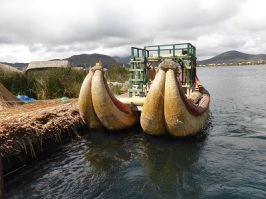

The Uros also make reed boats, two gondolas braced together like a catamaran, and these are used to ferry tourists about. We took a ride on one of these and the children entertained us with songs they had learnt at school – some in English as well as French. As we left each child came and shook our hands – they had been trained well.
Their very simple reed houses generally last about one year before they need repair and many are opting for plastic, timber and corrugated iron to extend the life span of the houses. Unfortunately these materials spoil the integrity of these settlements.
About two thousand people live currently in the Uros Islands off Puno (there are other settlements in Bolivia) and as Carlos explained, they may not last all that long into the future. The children go to high school on the mainland and many are being enticed by the trappings of modern city life – education, a job with real income, electronic gadgets with connectivity and a city social life none of which is on offer on the island. Carlos feels that in the future the culture may gradually disappear and at best (or worst) become a “Disneyland” experience to show what it was like in the past.
Puno to Uramamba
Posted on Mar 4, 2015
Since arriving in Peru we have noticed that there has been an invasion of Tuk Tuk’s. In fact there were so many in Puno that you could have sworn you were in India. Added to the Tuk Tuk’s are bicycle trishaws, and of course the vans, buses, trucks, bicycles, dogs and humanity in general. Driving through the towns gets pretty hectic so you need to have your wits about you. The reason for the Tuk Tuk’s -they are much cheaper than cars, and the taxi business is pretty lucrative here. Of course they don’t come with air bags or any other safety features and their drivers take huge risks squeezing in and around the traffic so you could be putting your life at risk getting into one. About 50 km after leaving Puno we arrived in Juriaca, a busy market town town which Rod had warned us about. At first it just seemed like a normal hectic town but on the outskirts the road deteriorated into a million huge potholes and then without warning had us criss-crossing the railway line with the rails protruding well above what passed for a road. One was so bad that all the cars scraped heavily and Pete became beached for a few moments until he managed to rock it free. The skid plate on our car hit so heavily that it bent one of the mountings so far out of shape that we needed a big hammer and angle grinder to remove and replace the mounting bolt.
Our destination today is Urubamba where we will stay the night and leave our cars in secure parking as we head to Machu Picchu by train. We passed over the Alto Plano (high plains) and crossed the highest pass so far – La Raya at 4,338 meters above sea level. A few kms later we got the first sight of a Peru Rail train similar to the one we will be catching tomorrow – all of the trains are meticuluosly cleaned and polished, so different to most of ours in Australia.
We then followed the course of the Urubamba River as it wound its way through the Sacred Valley. The land is so fertile that every available space is cultivated creating a rich tapestry of green. Already we are noticing how much more substantial the dwellings are for the rural people. The one roomed adobe houses have been replaced by homes of brick or rendered mud brick and terracotta tiled roofs. The Urubamba River provides much of the irrigation for the crops of corn, potatoes and quinoa. Cows, pigs, llamas and sheep are common, often being cared for shepherds, and not a tractor in sight.
We arrived at around 5.30pm to our accommodation at Tambo del Inka after covering over 400 kms. The prospect of not being in Navy Car for a couple of days was appealing and Ian hasn’t been feeling great the last couple of days.
Machu Pichu
Posted on Mar 4, 2015
The day didn’t begin well as Ian joined the growing number of our crew who have come down with the dreaded “South American Belly”. So out with the medical kit and drugs – Imodium, Antibiotics and Panadol to reduce the fever. Fortunately they worked sufficiently well in time for him to join us.
We left our cars in Urubamba where they would be secure, packed an overnight bag and caught the “Visadome” train to Machu Picchu Pueblo previously known as Aguas Calientes before the marketing people got into the act.
Machu Picchu is Peru’s number one tourist destination so we were not surprised to see so many people in town. The Peruvians manage the logistics of moving so many people with amazingly efficiency with buses leaving the station every few minutes to take the narrow winding road up to the citadel.
Machu Pichu is surrounded by a lush forest and perched on a saddle high above the Urubamba river gorge at an altitude of around 2400 meters. It sits between two mountains – Huayna Picchu (young peak) and Machu Picchu (old peak). During our 4 hours there the mist rolled in and out, the sun came and went, and the occasional sprinkle of rain had us reaching for our rain coats. Perfect weather for wandering around this ancient city. Built during the 14th century by the Inca Emperor, it was home to between 600 to 900 people. It is understood that Machu Picchu was never completed and was abandoned during the second half of the 16th century. It was never lost, as commonly thought, and was occasionally visited and inhabited by local farmers. In 1911 Professor Hiram Bingham visited the citadel and was so impressed by its beauty and majesty, that he returned the following year with a multidisciplinary team of professionals who began excavations and research. And so began the world’s fascination with Machu Picchu.
Some of us caught the bus up the mountain again on Friday morning to watch the sunrise, with bus loads of young travellers. Ross decided that our group of five had raised the average to around 40.
Cuzco
Posted on Mar 4, 2015
A rest day in Cuzco, the former capital of the Inca Empire and now a UNESCO World Heritage Site visited by over a million tourists every year. We are booked on a half day tour to see some of the archaeological sites starting with Tambomachay high up on the mountain side above Cuzco. Well maintained now it was almost lost to development in the 1970s before there was much interest in Inca history so private houses and farms border the park fairly discreetly. We were entertained by a mother and son shepherding their flock of sheep, goats and llamas along the fenceline just behind the restored remains.
Then it was off to the nearby fortress of Sacsayhuaman, a vast area of huge interlocking stone walls and other remains where the Inca attempted to withstand the Spanish. Unfortunately they lost the battle and only 30,000 of the original Cuzco Inca population of 250,000 survived.
The final stop was the Inca’s most sacred building in Cuzco, Korikancha or Temple of the Sun which was flattened by the Spanish to form a site for their Santo Domingo church. There are now excavated remains of the original Temple on display showing some of the technologies used by the Inca to enable the buildings to survive seismic activity. The technologies included interlocking stones along with hidden metal links which helps explain why these and the Machu Pichu structures have survived more than 500 years in an area which has such regular seismic activity.
The afternoon was free and we had booked a service centre to give the cars some attention before heading for Lima. The booking was made with the help of Rod, our travel agent and his brother-in-law, Zac who has lived in Cuzco for 10 years and now operates a microbrewery there. Rod and later Zac were both involved in operating bus tours in South America and the major function of the service centre is to maintain a fleet of large 4WD buses – a declining business because there are now few unsealed roads and tourists prefer luxuries like aircon and wifi. What a soft bunch!
Navy Car needed a little extra work apart from the usual grease and oil change. Our skid plate had taken a bit of a beating in Juliaca where the road lead us across the railway lines and a hidden 20 cm drop on the other side. One of the skid plate mounting bolts took a direct hit, ouch, and couldn’t be removed so an angle grinder came to the rescue. Meanwhile Zac had picked up our dead starter early in the morning for a rebuild so with the skid plate out of the way this could be reinstalled and we were all back in top shape again ready for another day.
To celebrate our success, a small group decided to test Zac’s brew at the Norton Bar right on the main square. His Zenith range got the thumbs up but the real surprise was the featured beer – Old Speckled Hen. Now very few Peruvians would know the connection between Old Speckled Hen beer and MGs. The beer is brewed in Abingdon UK and named after the MG vehicle used by the factory in the 1920s to test new bits on the test route around Abingdon – apparently its bodywork wasn’t exactly pristine so someone gave it the nick-name Old Speckled Hen so why not call a beer after it…
Cuzco to Nazca
Posted on Mar 5, 2015
Only three more days to go before we hand over the car to Simon and Maddy in Lima. After 14,000 km and a bit of tweaking along the way it’s running better than ever and with a rebuilt starter we feel confident about making it to Lima alone after we leave the rest of the group in Nazca. The run from Cuzco to Nazca is over two days with an overnight stop in Abancay which still needs to discover something exciting before it becomes a tourist destination – or maybe they are happy to be left alone. The town just happens to be located in a valley between two 4000m passes which wind through some of the most beautiful lush scenery imaginable. Like the NSW North Coast but with slightly higher mountains. The only vegetation which looks out of place are the eucalypts which dominate the mountain sides even up to 4000m. It seems remarkable that they have taken over from so many local species in each of the countries we have passed through from Chile and Argentina to Bolivia and now Peru. They are used for structural timber and firewood but no-one seems too fussed about their effect on the environment. Fortunately they haven’t yet intruded far into the Sacred Valley around Machu Pichu but they are only around 20 km away.
That evening in Abancay we are treated to the sounds of a band marching down the street preceded by groups of dancers in elaborate and colourful costumes. An extension of Carnival, the procession is held each year to mark the start of Lent so everyone is getting into it before the chill of whatever abstinence takes their fancy.
The next day’s drive through to Nazca on the coast is our last with the group so we get the honours of taking the lead. You would have though by now that we would have gone with instinct rather than the GPS but no, we were Garmined again leaving Abancay. Still, most agreed that it was an interesting drive down an ever narrowing rutted track before, with the encouragement of a few locals, we finally arrived back at the main road. Boring! But as we climbed further to around 4550m the road became more interesting . Very challenging with many hair pin bends, no safety Armco and sheer drops to the valley below. Beautiful scenery, snow covered peaks in the distance and flocks of Alpaca’s. We reached over 4500m three times over the next 250 km, sharing the road with trucks and road-repairing vehicles. We managed to avoid a number of recent rock falls and saw more accidents in one day than we had seen the last two months, including 2 overturned semi’s and a burnt out tourist bus. The last part of the drive into Nazca involved a drop of 3000m in 30 kms, mostly through thick fog. We were now at around 500m and in the Atacama Desert – reportedly the driest region anywhere in the world.
Nazca is a dusty desert town and on first sight not very appealing, full of trucks, buses, Tuk Tuk’s and bikes. We were on the hunt for fuel, some cars more desperate than others. Red and Green cars had already run out and topped up from their jerry cans. Then the most important and often the most challenging part of the day – finding the accommodation. It wasn’t where the Garmin suggested, so we asked at the servo. It was in a hacienda a few kms out of town, accessed via an unmade road (of course!). Will have to leave cleaning the car to Lima now.
This was our last evening together and the others are leaving early in the morning to fly over the famous Nazca Lines. Lots of good wishes and toasts on both sides – for everyone else who is continuing to the US and Canada and for us as we head for Lima and the Galapagos. We’re all looking forward to the get together back in Australia when it is all over.
Nazca to Lima
Posted on Mar 5, 2015
Our last day and we are driving solo to Lima while the rest of the group spend another day in Nazca taking light plane trips over the Nazca Lines. We are very tempted to join them but we don’t have much information on the road ahead and want to get to Lima as early as possible to catch up with Simon and Maddy. A nail-biting moment as we load the car and turn the key to hear a dull clunk as the starter solenoid refuses to engage – again. Five more times the clunk is repeated before the starter whirrs into life and we get away. Phew!
We stop in around 20 km at the viewing platform for some of the Nazca Lines closest to the highway – not the same view as the others will have had but at least a feel for the size of the mysterious shapes created in some earlier time.
Then off for the remaining 430 km knowing that we can’t afford to switch the engine off unless we can find a good down slope to get started again. The road is much slower than we expected, at first winding through desert passes and then through several busy towns including Ica and Pisco – the home of the famous Pisco Sour cocktail. With around 200 km to go we still hadn’t found anywhere to stop and the road became a 4 lane Auto Piste running parallel with the coast. At least we could cover some distance quickly but what a lost opportunity. In any other country you might have expected plenty of exits down to beautiful sandy beaches but this road is lined with never-ending sheds housing battery chickens – hundreds of them, probably producing eggs for export markets all over the Americas. And the smell! Wherever there was a gap in the egg farms there were desolate communities living in tiny shacks with no water or electricity. A tough life for some.

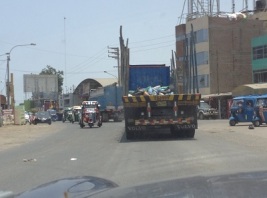

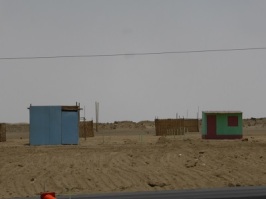
Finally the desert gave way to irrigated green areas and we are in Lima – a sophisticated city of 9 million people. The Country Club Hotel is a bit of misnomer now. Built in the 1920s it is a grand hotel right opposite the golf course now smack bang in the middle of the financial and embassy districts. We feel a little under-dressed being welcomed with a glass of champagne among all the beautiful people of Lima while we are dressed in shorts and T-shirt but they probably haven’t just had the adventure we have had.
Now for the next adventure.
PS Just heard from Simon that the starter has been repaired. Once again full of water and mud, probably from all the water crossings on the road from Cusco after the last repair. Lorraine suggested the skid plate may be directing spray from the front wheel straight into the starter. I think she may be right – obviously hanging around engineers far too long, she is starting to think like one!

